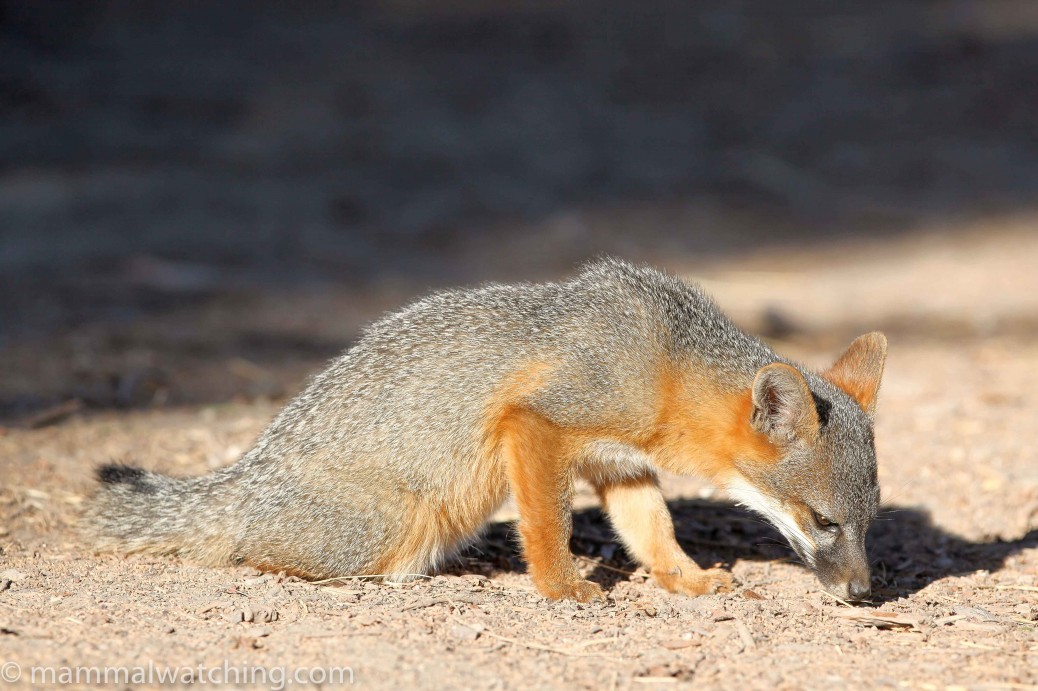
California
California has very varied habitat (from desert to tundra) with a corresponding diversity of species, coupled with incredible scenery and some of the most productive cetacean viewing in the world, which make it a top mammal watching destination. I first visited in 1998 for ten days and barely scratched the surface. I have returned many times since then.
This page splits California into five broad (and rather fuzzily defined) regions: North Coast (north of San Francisco); Central Coast (from Santa Barbara to San Francisco); South Coast (south of Santa Barbara); the Mountains (including Yosemite); and Desert (including the Mojave and Joshua Tree parks).
North Coast
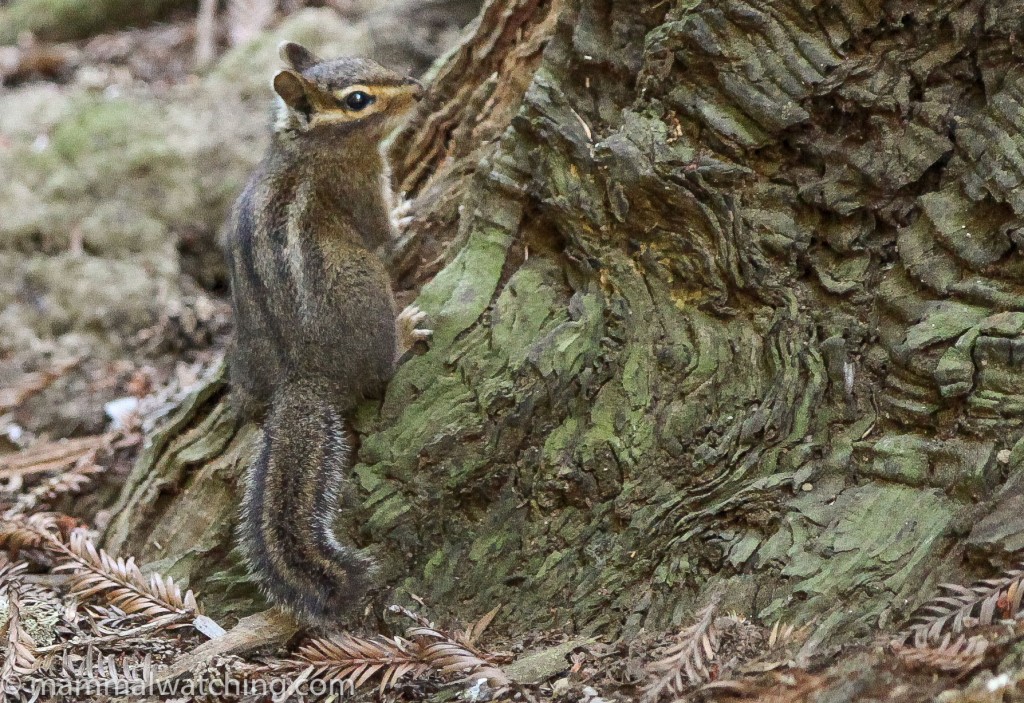
Yellow-cheeked Chipmunk, Neotamias ochrogenys, Humboldt Redwoods State Park
Humboldt Redwoods State Park
The State Park, and the nearby Albion Field Station, are good places to see the endemic Yellow-Cheeked Chipmunk. I saw Western Deer Mice and a Gray Fox too at the Field Station in July 2013.
Mount Shasta
I saw a Mountain Pocket Gopher here in June 2020.
Muir Woods
Muir Woods, just over the Golden Gate Bridge north of San Francisco, is a reliable spot to see Sonoma Chipmunks, even if I had to visit three times before I saw one. It was foggy and very crowded on my first visit in July 2013. In October 2013 it was closed because of a government shutdown. But in November 2014 I saw two right at the entrance at 8 a.m. They should also be common around the cafeteria area. Western Gray Squirrels were all over the car park too.
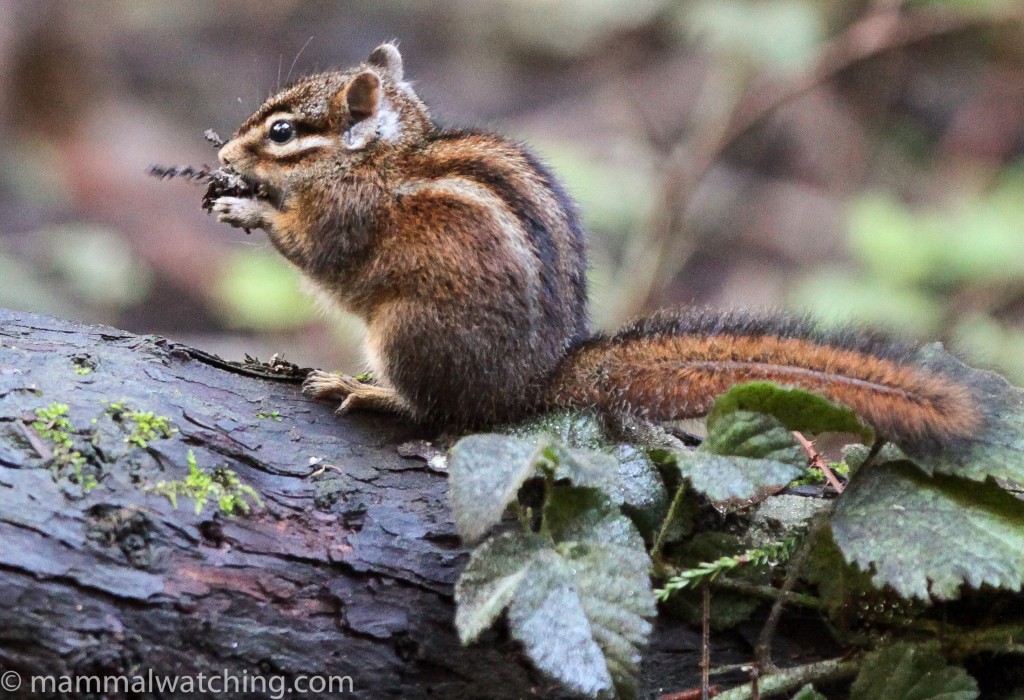
Sonoma Chipmunk, Tamias sonomae, Muir Woods
Orick
In June 2020 I saw a Pacific Jumping Mouse on the road past Lady Bird Johnson Grove.
Point Reyes National Seashore
I was here in September 1998 & April 2013. The Black-tailed subspecies of Mule Deer (race Columbianus), and the Tule subspecies of Elk (race Nannodes). Though there is a lot more to see here including Elephant Seals on the beach (which I saw in 2013). Its also a good spot for River Otters and Long-tailed Weasels.
San Francisco
In September 1998 there were California Sea Lions at Pier 39 in the middle of the harbour. Check out the local natural history society boat trips to the Farallone Islands to see Blue Whales in September (saw plenty of other cetaceans too on a day trip there).
Sonoma County
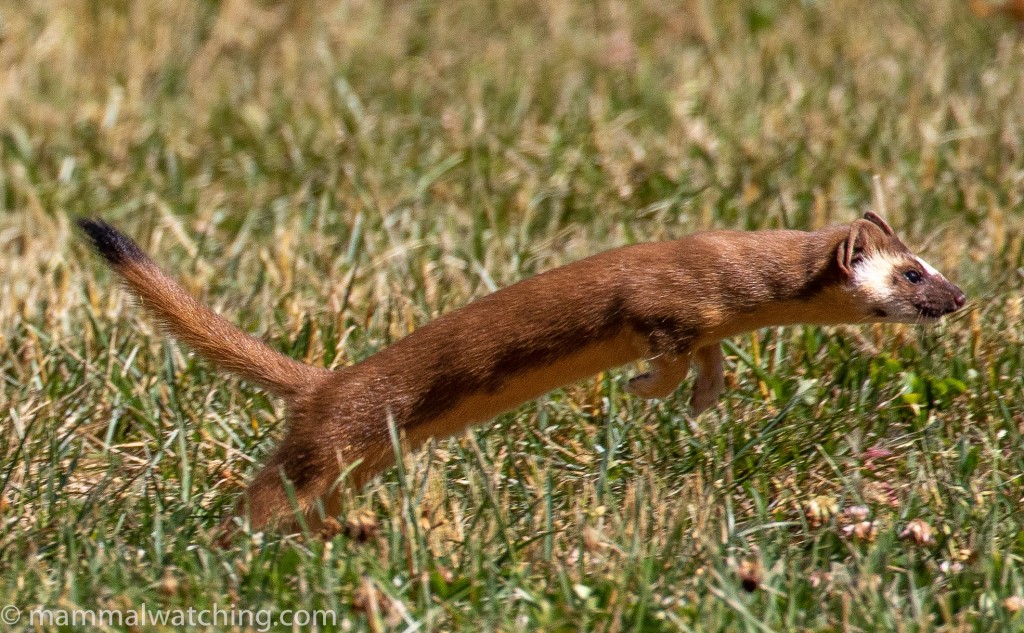
Long-tailed Weasel, Mustela frenata
In June 2020 Long-tailed Weasels – a nemesis species for me! – were easy to see at a town park in Sonoma County where they have bred for several years. The weasels are usually around until the end of May I was told.
Central Coast
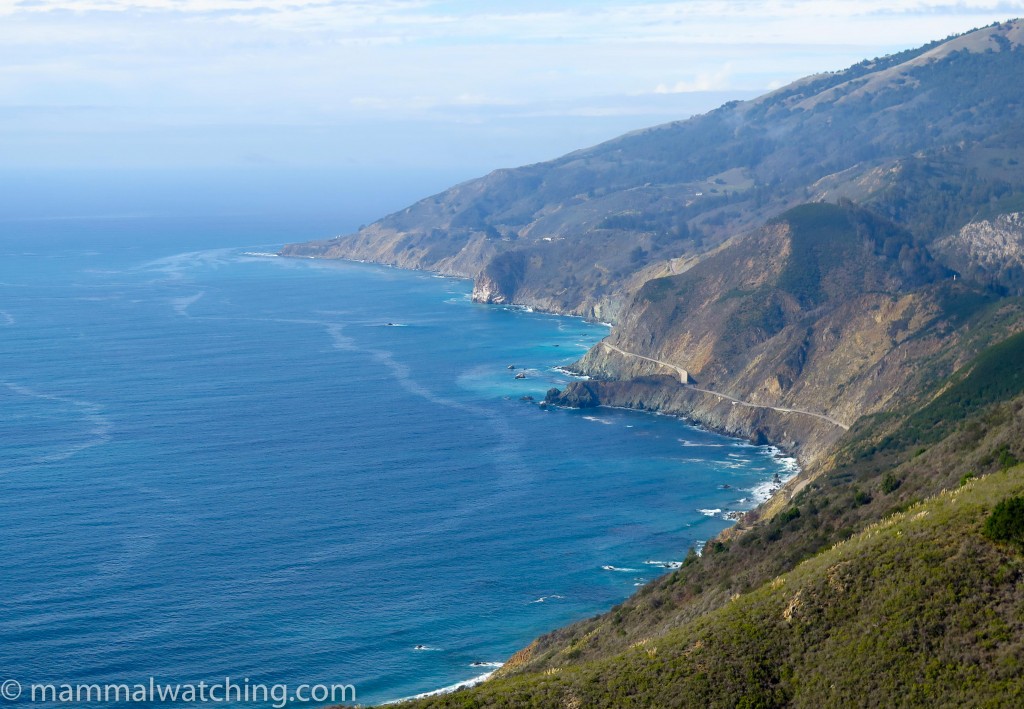
Big Sur between Monterey and San Simeon
Andrew Molera State Park
In September 1998 I saw Gray Fox, Raccoon and dozens of Yuma Myotis skimming the river near the car park.
Ano Nuevo
In September 1998 California Field Voles were common along the trail to the beach. There were Northern Sea Lions here too though you need a scope to find them among their more numerous Californian cousins.
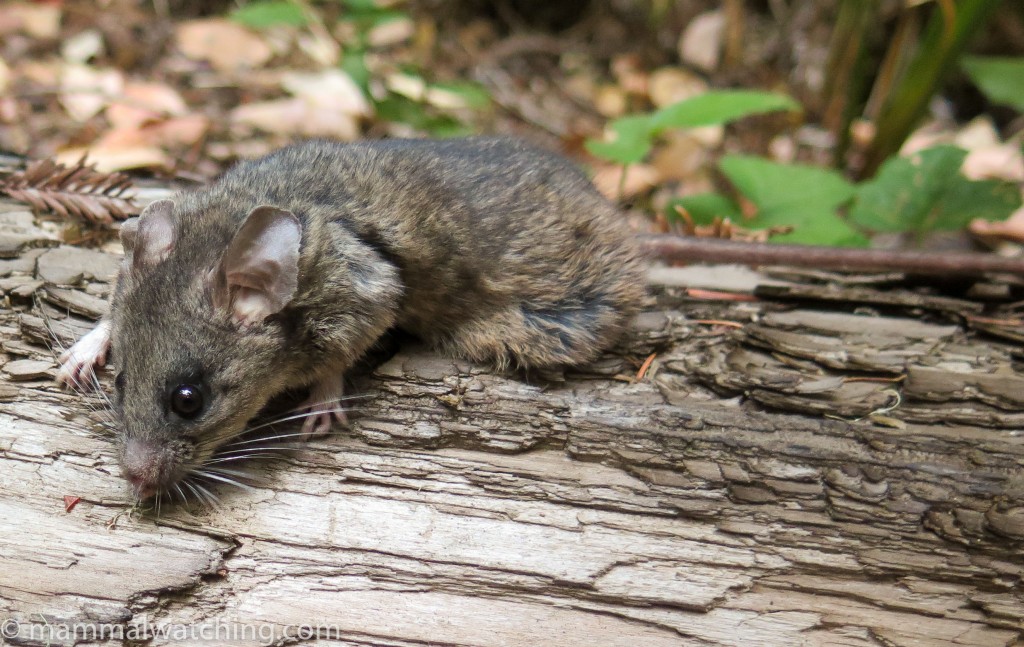
California Mouse, Peromyscus californicus, Boulder Creek
Boulder Creek
In August 2015 Brian and Eileen Keelan put me up for the night at their lovely house deep in the Redwoods. Their backyard was full of Merriam’s Chipmunks, and we caught some fabulous California Mice nearby.
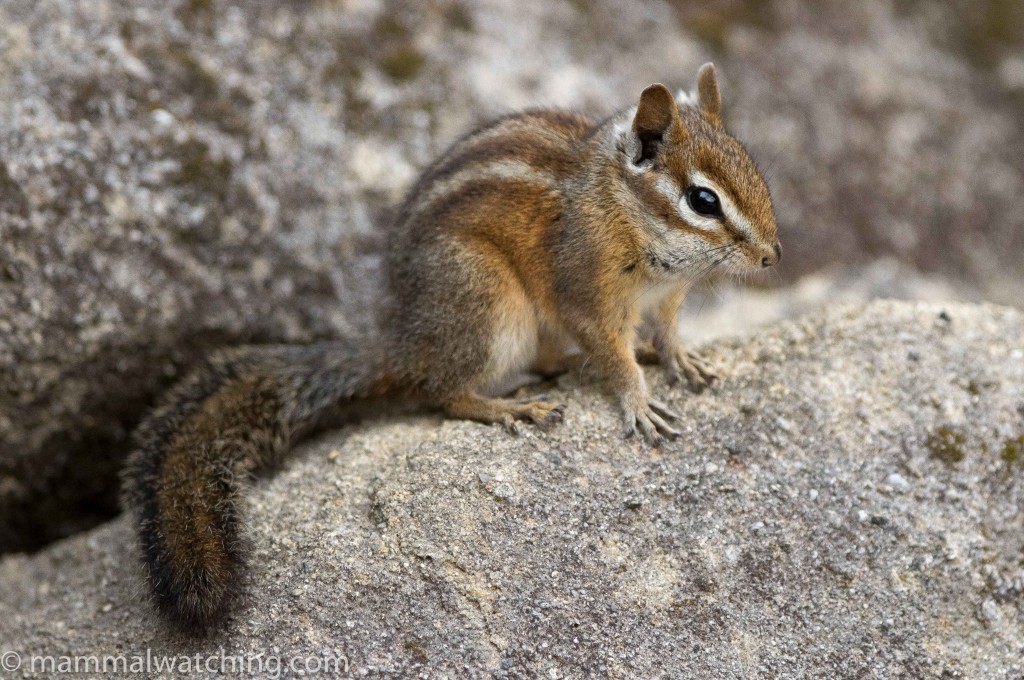
Merriam’s Chipmunk, Neotamias merriami, Boulder Creek
Lake Lopez
I saw a Bobcat here at dawn in September 1998.
Los Padres National Forest
This forest, inland from the Big Sur, has some interesting stuff (see Fiona Reid’s trip report about her visit to Cone Peak). In late November 2014 it was less productive – possibly because it was colder – although driving along the Naciemento-Ferguson road through Fort Hunter-Liggett was good with lots of California Ground Squirrels in the daytime and Mule Deer, Coyotes, Elk, Desert Cottontail and Feral Pigs after dark. I set a few traps along the roadside when I was out of the national forest and caught a bunch of Gambel’s Deer and Brush Mice plus my first Big-eared Woodrat.
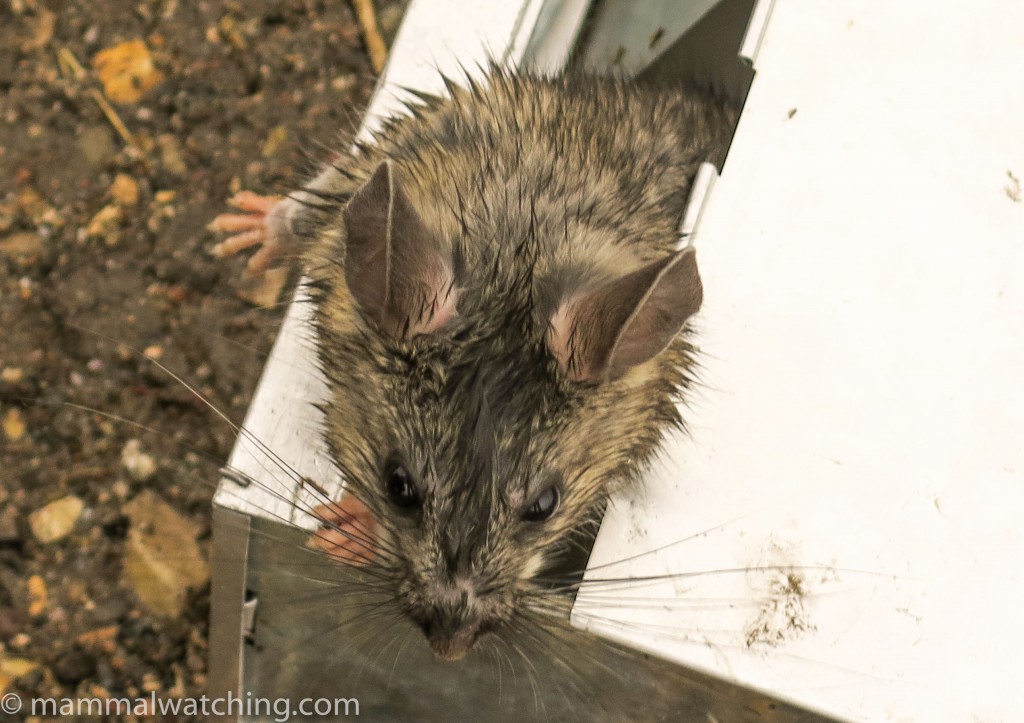
Big-eared Woodrat, Neotoma macrotis, emerges from the trap, Los Padres National Forest
Monterey & Carmel
This area offers some of the best cetacean watching in the world. During three 4-hour trips in September 1998 with Monterey Bay Whale Watch we had Blues, Humpbacks, and a Fin and Minke whale, Common and Pacific White-sided Dolphins (the former in pods of many hundreds), Harbour and Dall’s Porpoise and Risso’s Dolphins. I dipped on Northern Right Whale Dolphins (not uncommon), Orcas (regular) and Baird’s Beaked Whales (seen several times most Septembers). Sea Otters and Harbour Seals are around the wharf and I saw a California Ground Squirrel in town.
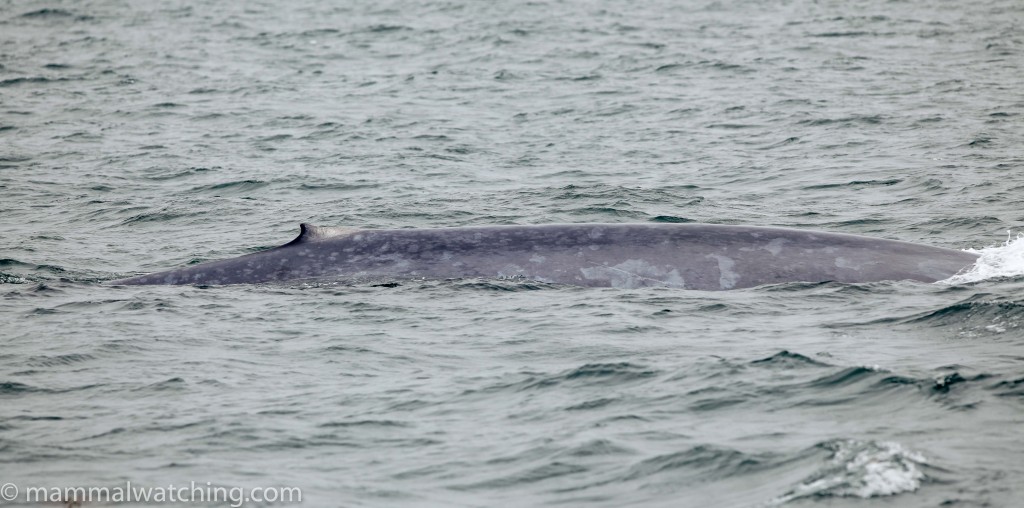
Blue Whale, Balaenoptera musculus, Monterey
I took a half day trip again in late July 2013, and saw a Blue Whale, along with 100+ Rissos, and a few Pacific White-sided and Common Dolphins, plus Humpbacks just off the harbour, and the usual Harbour Seals, California Sealions and Sea Otters in town.
In May 2016 I was back for a day’s whale watching and successfuly found a huge mixed pod of 4,000 Pacific White-sided and Northern Right Whale Dolphins (species that had just returned to the bay after a long absence), along with 20 or so Transient (Bigg’s) Killer Whales and many Humpbacks. See my 2016 trip report. And I was back in October 2017 and saw all of these species I had seen in the past during two days at sea.
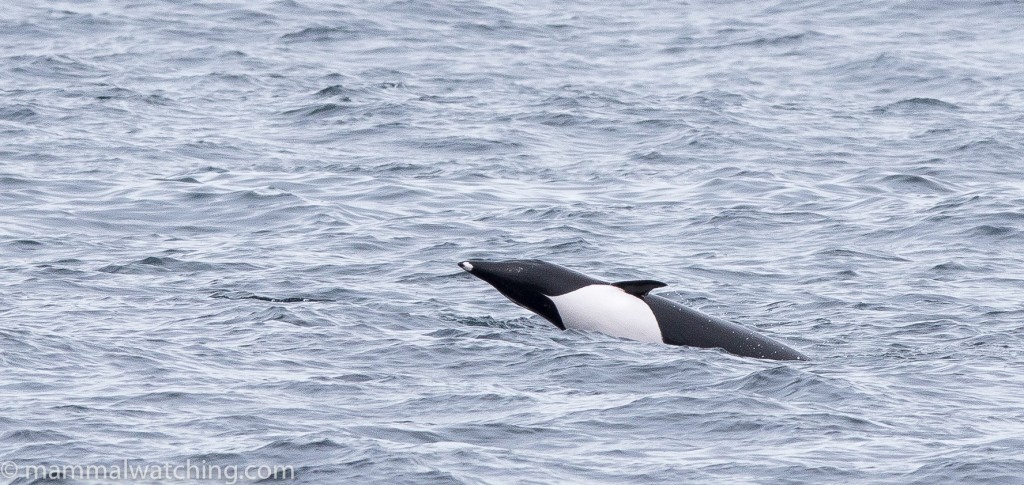
Northern Right Whale Dolphin, Lissodelphis borealis, Monterey
In Carmel I caught a couple of Western Harvest Mice and a Gambel’s Deer Mouse and saw a Brush Rabbit in 2013. In 2016 – in the Carmel Valley – I caught several California Mice and California Pocket Mice, Brush Mice, a Pinyon Mouse and a Big-eared Woodrat.
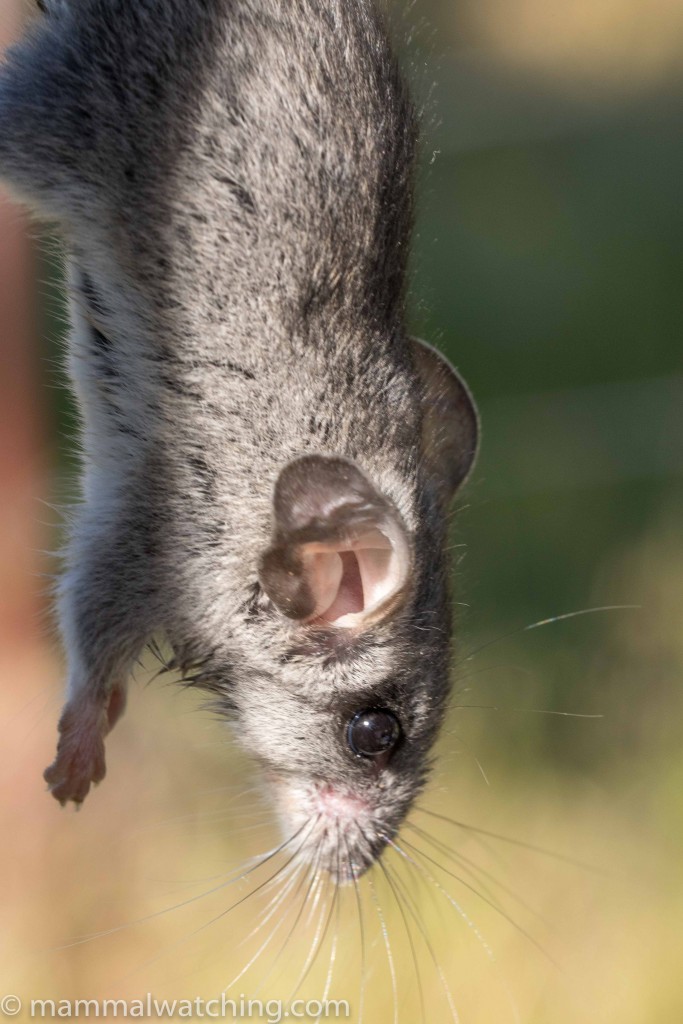
Pinyon Mouse, Peromyscus truei
Panoche Hills
I visited here in May 2016 and saw a few Heerman’s Kangaroo Rats, a Bryant’s Woodrat, Black-tailed Jackrabbits, Desert Cottontails, California Ground Squirrels and San Joaquin Antelope Squirrels. See my 2016 trip report. I spent an evening spotlighting here in 2017 and saw some Giant Kangaroo Rats and a couple of Kit Foxes among other species.
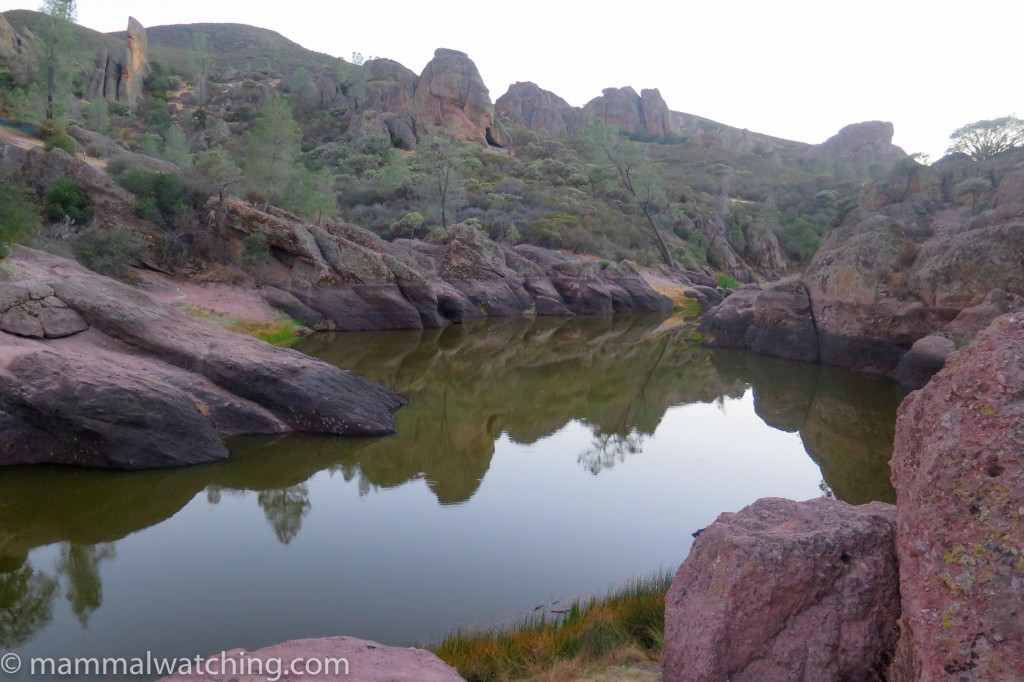
The Reservoir at the Pinnacles National Park
Pinnacles National Park
This is a fabulous park. In August 2015 Brian and Eileen Keeland invited me batting for a night here to look for Western Mastiff Bats. Using his bat detector, Brian was able to identify 10 species, some of which we also saw in flight including many of the huge Western Mastiff Bat, North America’s largest species, and our main target for the evening (see Brian’s notes here). I could hear them quite easily with the naked ear, and we picked up several in the spotlight: their large size and colour, along with their audible calls, making them simple to identify. We also saw many Western Pipistrelles over the reservoir and at least one Californian Myotis flying up and down the trail near the carpark at 11 p.m. (and identified by Brian with the detector). Other species we recorded, but I wasn’t sure I saw, were Big Brown and Little Brown Bats, Silver-haired, Fringed and Western Dark-nosed Myotis, Pallid Bats and Townsend’s Big-eared Bats. Other mammals in the park that night included a Gray Fox and some Mule Deer.
I returned in October 2015 with my kids for a night to the eastern side of the park (near the village of Paicines). There were no rodents running around during the first hour after dark (I don’t suppose the full moon and the horrendous drought helped) and all we saw were some Mule Deer and a Feral Pig. We did catch one Heermann’s Kangaroo Rat the next morning which I couldn’t manage to turn into the Narrow-faced Kangaroo Rat I was looking for.
In May 2016 I was back for another night’s spotlighting. I still couldn’t find a Narrow-faced Kangaroo Rat, but did get a brief look at a Dusky-footed Woodrat towards the top of Bear Cave, about five minutes before the reservoir. See my 2016 trip report.
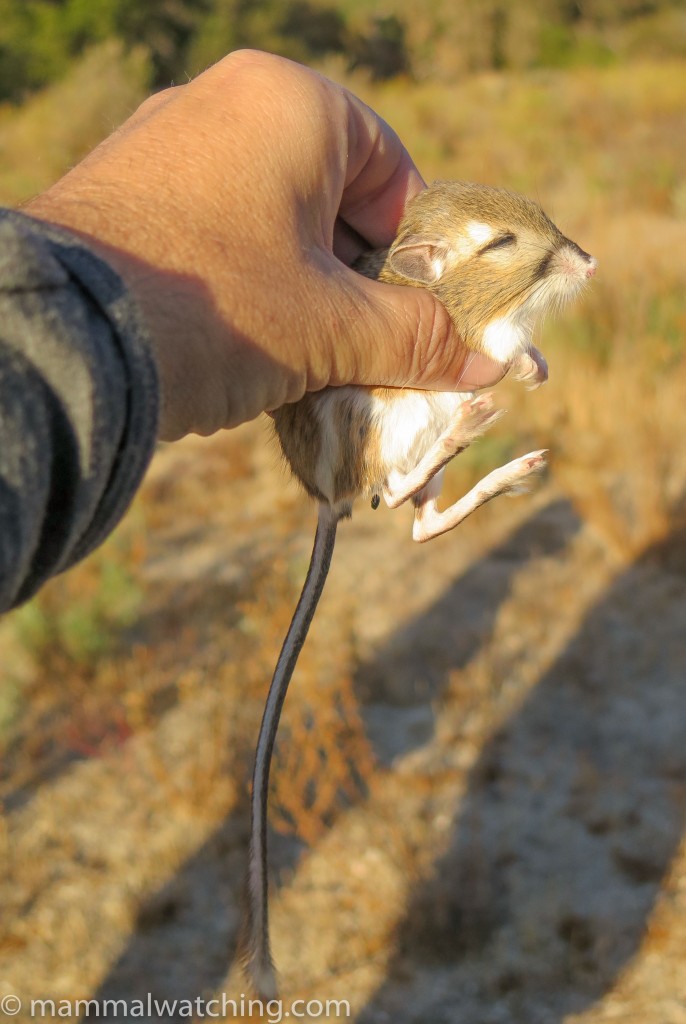
Heermann’s Kangaroo Rat, Dipodomys heermanni, Pinnacles NP
Point Piedras Blancas
The beach here is a great place to see Northern Elephant Seals.
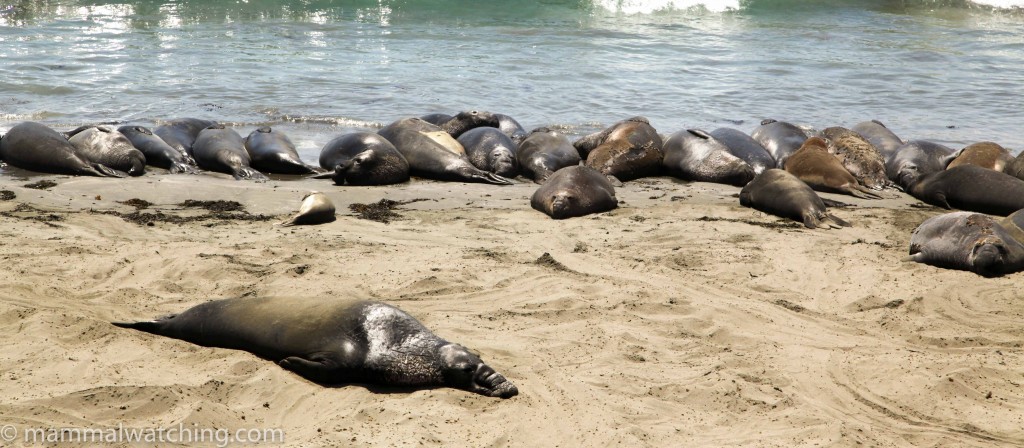
Northern Elephant Seals, Mirounga angustirostris
Route 1
Probably the most beautiful coastal drive in the world, Route 1 heads south of Monterey, hugging the coast to near L.A. Mammals I ahve seen along here during a few visits include Brush Rabbit, Northern Elephant Seals, White-sided Dolphins and California Ground Squirrels. Just check out any of the view points for the squirrels.
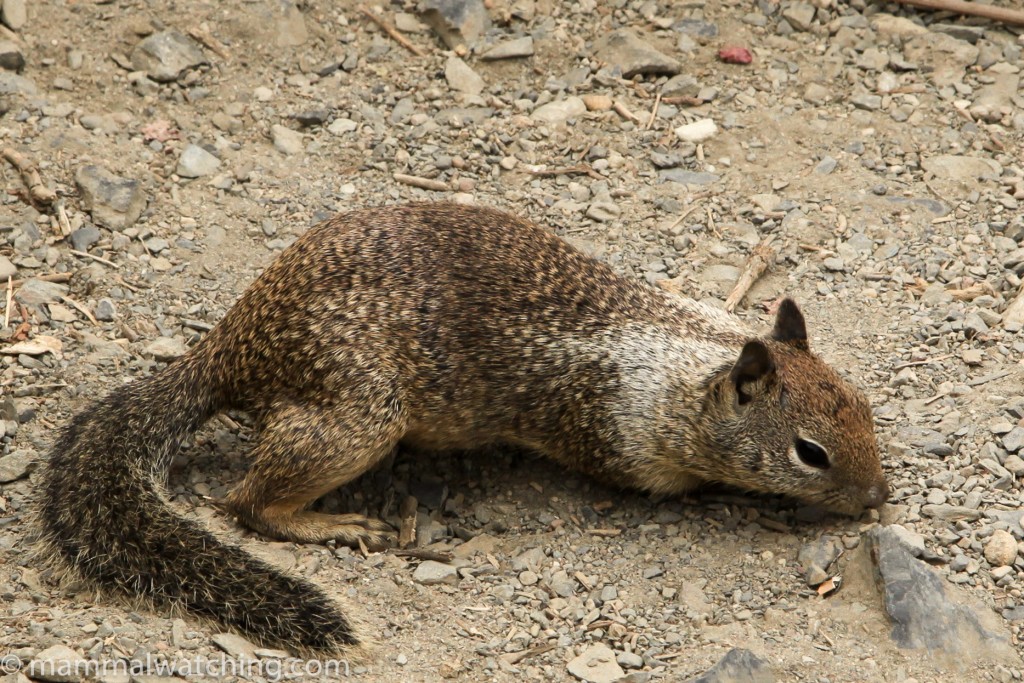
California Ground Squirrel, Otospermophilus beecheyi, Route 1
South Coast
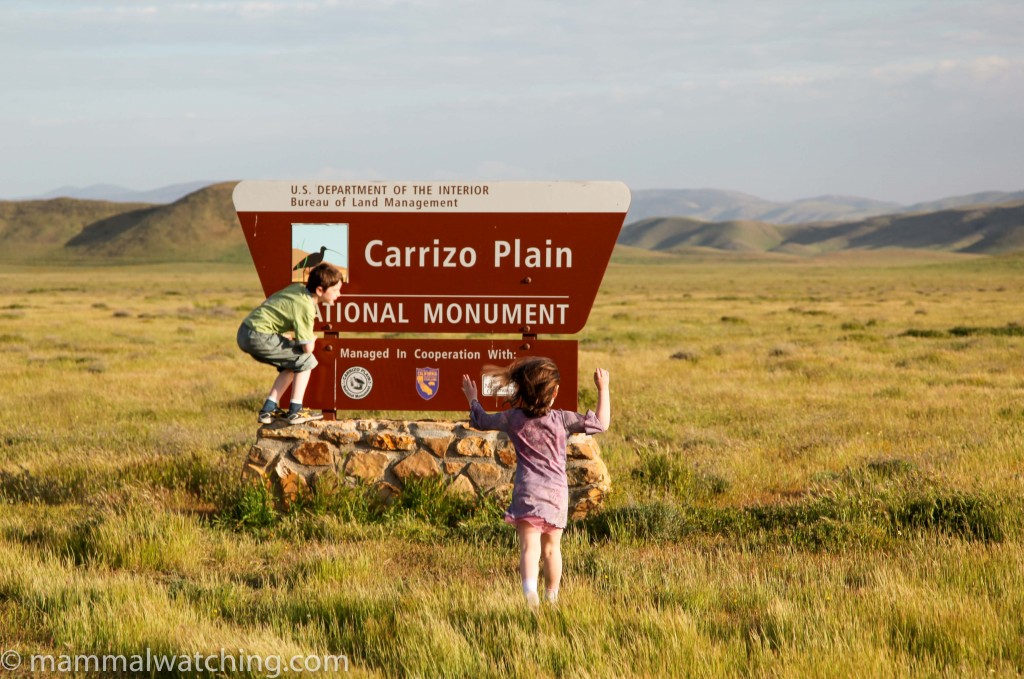
Carizo Plain National Monument
Carizo Plain National Monument
I first visited here in April 2010 with my kids. We saw some California Ground Squirrel en route from L.A. and Nelson’s Antelope Squirrels were quite easy to see in the evening inside and outside the park. I drove along the long park road just after dark and saw at least one Kit Fox on the road and more than 20 kangaroo rats, most of which were the quite rare Giant Kangaroo Rats. I also saw a couple of Black-tailed Jackrabbits.
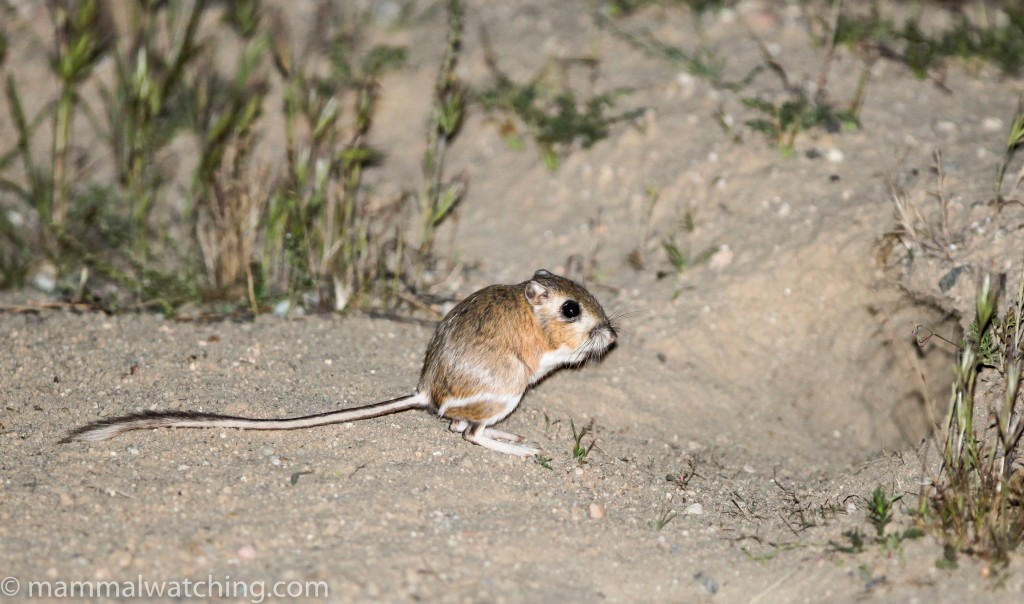
Giant Kangaroo Rat, Dipodomys ingens, Carizo Plain
I went back for a night in June 2011 and saw more Giant Kangaroo Rats (again near the visitors centre), a Kit Fox, a few more jackrabbits and further south lots of Heermann’s Kangaroo Rats and a few of the much smaller San Joaquin Kangaroo Rats on the road.
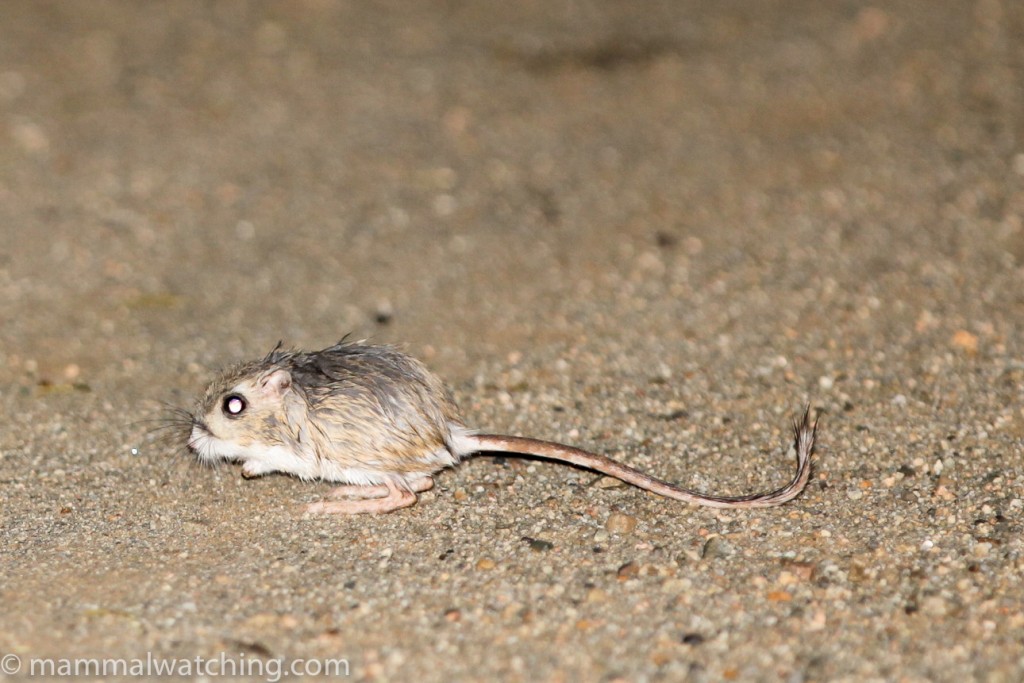
San Joaquin Kangaroo Rat, Dipodomys nitratoides, Carizo Plain
Channel Islands National Park
I spent a night here in August 2010 with my kids and Matt Miller. We camped on Santa Cruz Island, primarily to see the endemic Island Foxes. The sea was alive with Common Dolphins during the ferry trip over, and there were some California Sealions in Ventura Harbour. Fox numbers have recovered very well on Santa Cruz and if you cannot find one you should hang up your binoculars! We must have seen 20 of them around the campsite in the evening, night and morning as well as on the trails. The animals in camp were fearless.
I could not find any of the Western Spotted Skunks which were reportedly pretty common, though I discovered that their numbers appear to have declined considerably in parallel with the recovery of the fox. The skunks are often around the campsite but despite wandering around for four hours with a light I couldn’t see one. It was a full moon which perhaps didn’t help but I was told they are much more skittish than the foxes and tend to keep more to the shadows. Frustratingly I met a fox researcher who had just finished trapping on the island and had caught a Skunk that morning (as she had done every morning she had set her traps).
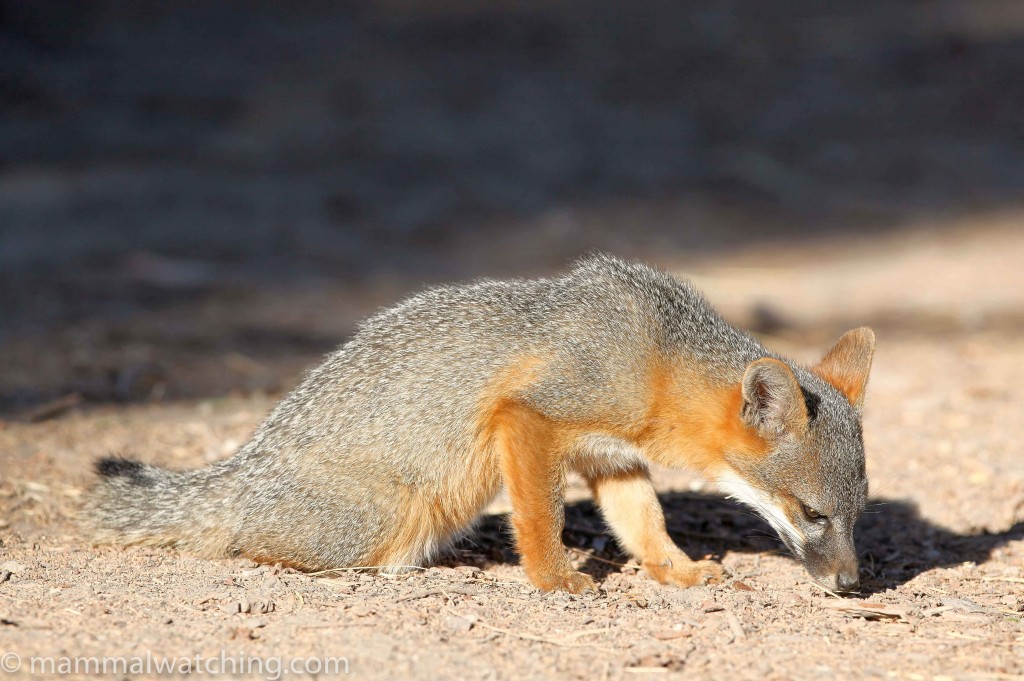
Island Fox, Urocyon littoralis, Channel Islands NP
Townsend’s Big-eared Bats roost in the old bakery next to the visitor centre and you can watch them leave the roost through the bakery door at dusk, though access to the building is blocked off. There was a Harbour Seal hanging around the Scorpion Anchorage too.
Frazier Park
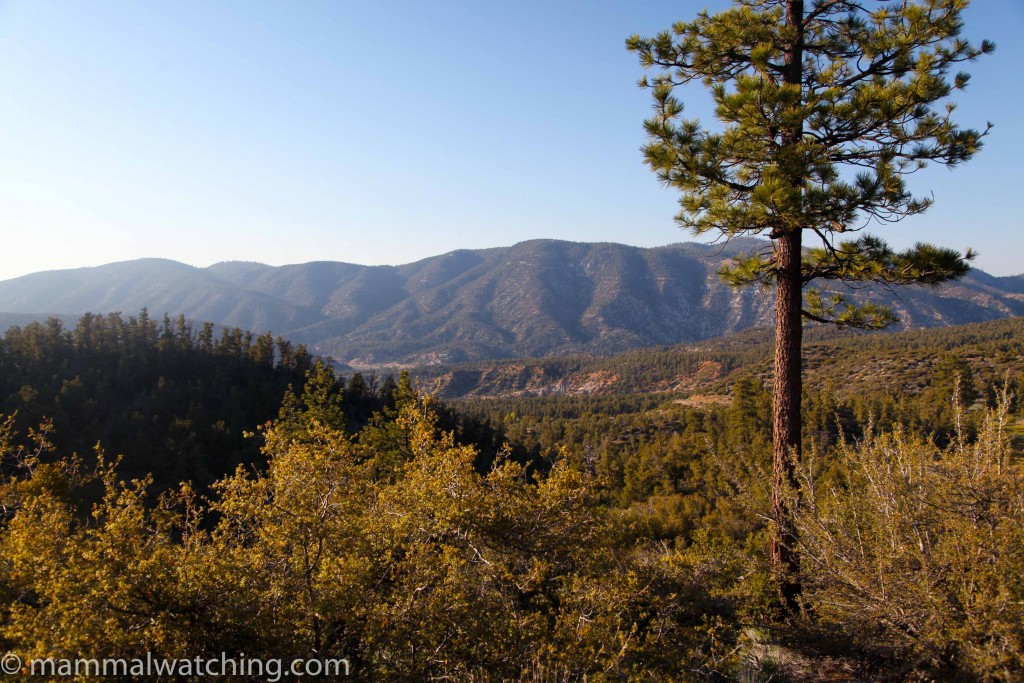
Chuchupate Campsite
In June 2011 on the way back to L.A. from Yosemite I stopped in at the Chuchupate Campsite, off Lockwood Valley Road just west of the town of Frazier Park. As I’d hoped it was full of Merriam’s Chipmunks. I saw a few running around, and once I started squeaking at least a hundred replied. I thought at first they must be birds or insects. They were not however very cooperative for photos and were hard to coax out of the shrubbery.
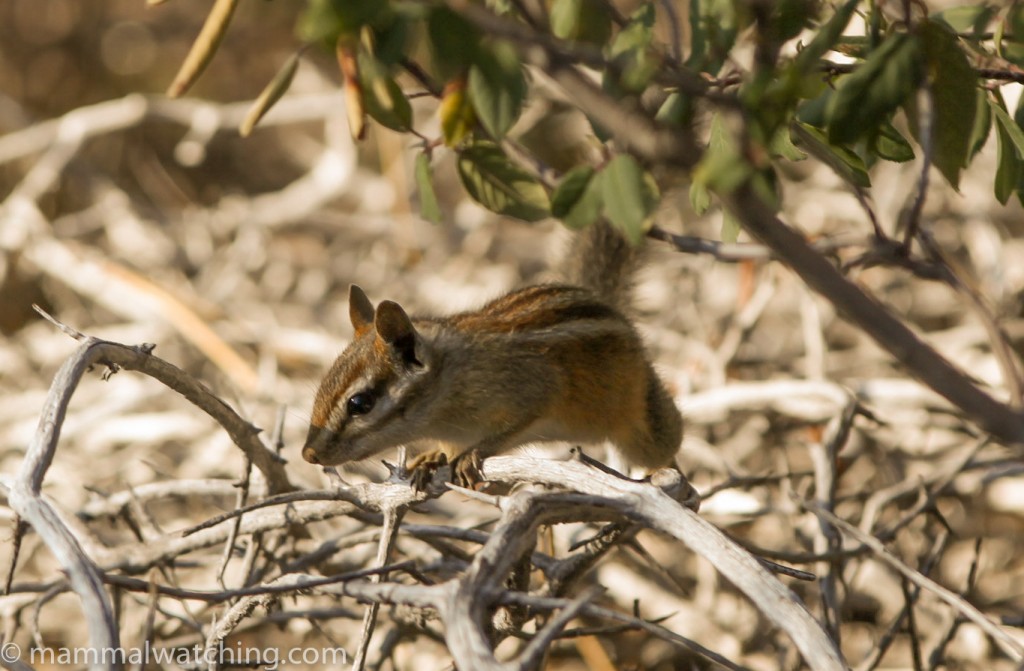
Merriam’s Chipmunk, Neotamias merriami, Boulder Creek
Mountains
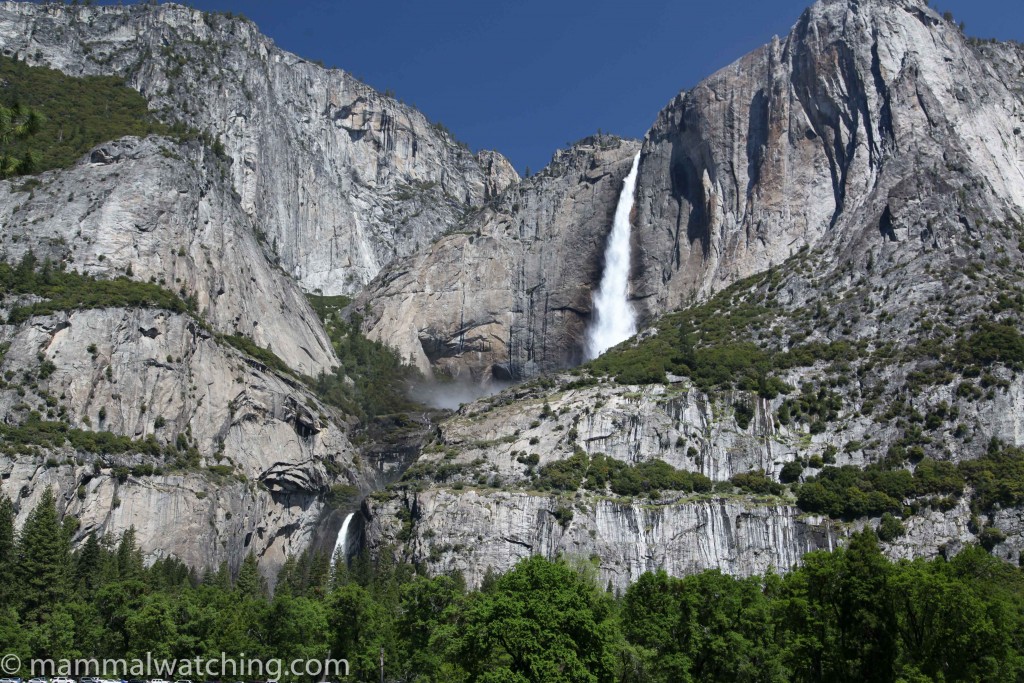
Yosemite Valley
Lassen National Forest
In August 2015 I stopped Battle Creek Campground (a mile west of the small town of Mineral) on my way to and from Lava Beds National Monument. The campground was, at least in 2006, home to only one chipmunk species: Allen’s (Shadow) Chipmunk.
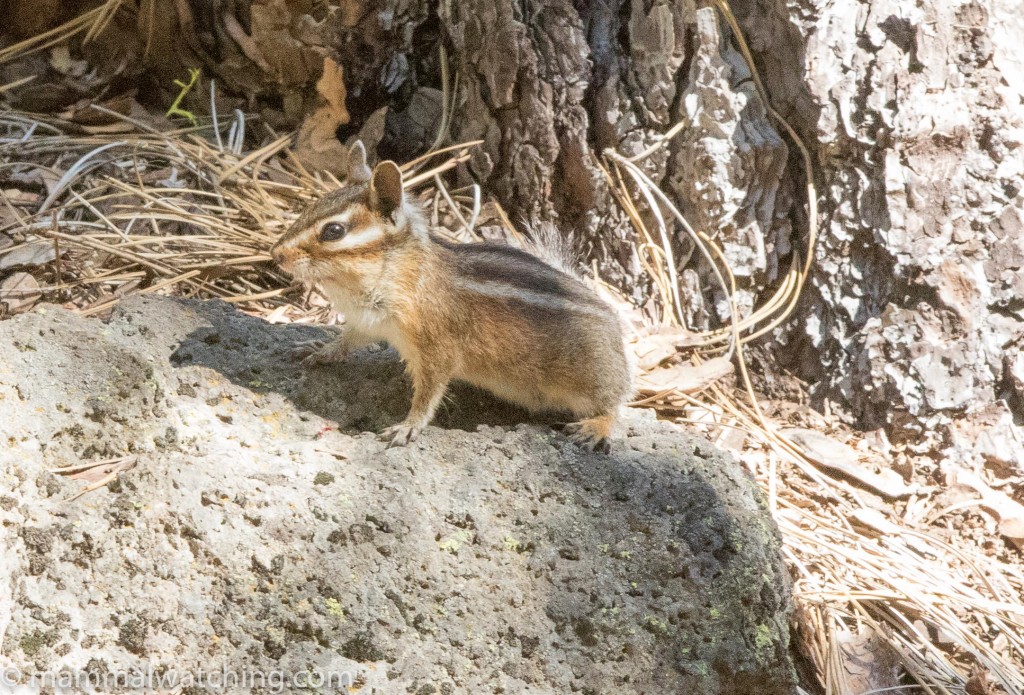
Allen’s Chipmunk, Neotamias senex
I saw only one chipmunk in the mid-afternoon, but found many the next morning. Most chipmunks seemed to be Allen’s but, as so often is the case, it can be quite hard to decide.
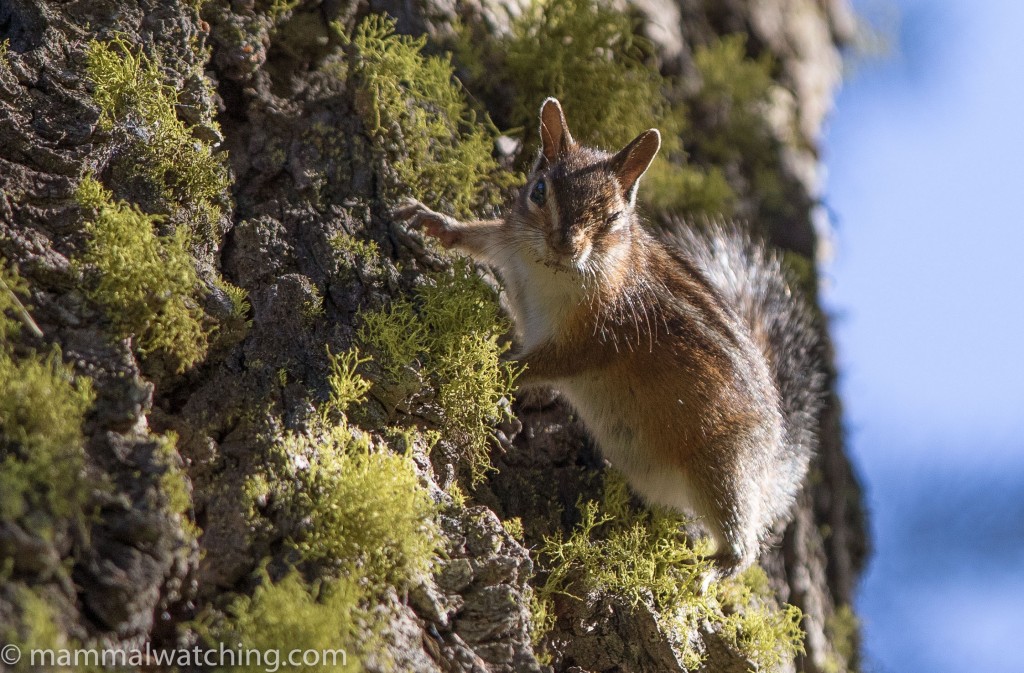
Allen’s Chipmunk, Neotamias senex
Golden-mantled Ground Squirrels were very common, and I also saw several Douglas Squirrels and some Mule Deer.
Lava Beds National Monument
Brian Keelan recommend Lava Beds N.M. as a good spot for California Kangaroo Rats and I stopped for a night in August 2015. California Kangaroo Rats were indeed abundant and unusually confiding for kangaroo rats. I saw them in the campground, many on the roads (especially in the north of the park), and along the Cave Loop road that leads from the visitor centre, which is closed to traffic after dark, so makes for great spotlighting. I also saw at least one Great Basin Pocket Mouse in the visitor centre car park.
Other mammals included Mule Deer, Pronghorn, Mountain Cottontails and Black-tailed Jack Rabbits.
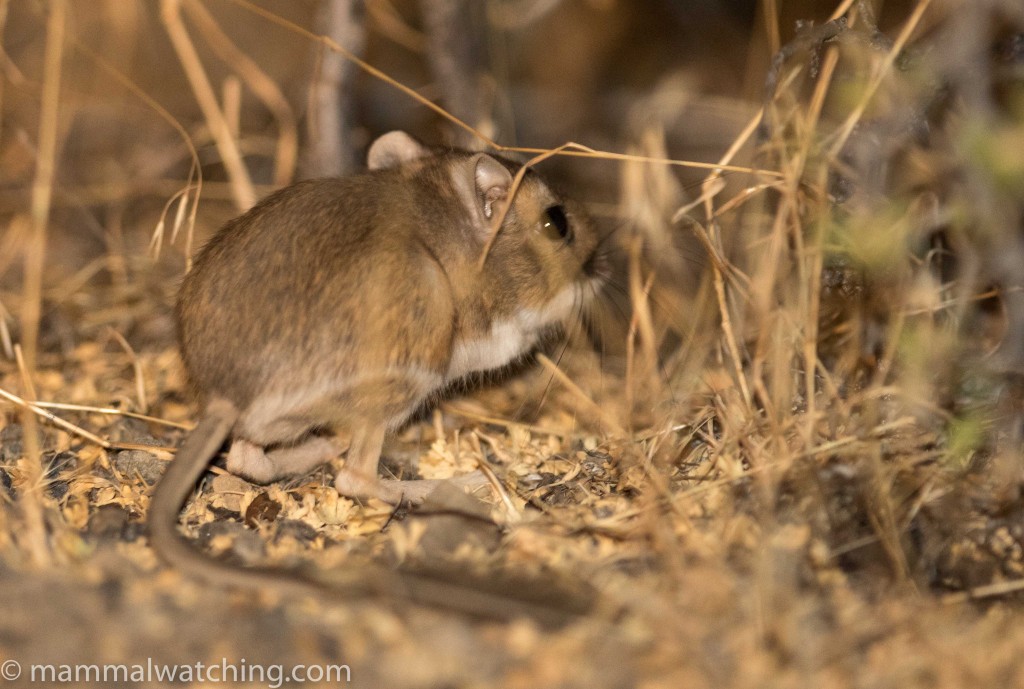
California Kangaroo Rat, Dipodomys californicus, Lava Beds NM
Mono Lake
Vladimir Dinets gave me some detailed advice on where to look for several species of rodents he had seen in May 2015 on the north and south side of Mono Lake. We weren’t as successful as him, though a full moon and near freezing minima over night probably didn’t help. But I did catch a beautiful Panamint Kangaroo Rat (my first).
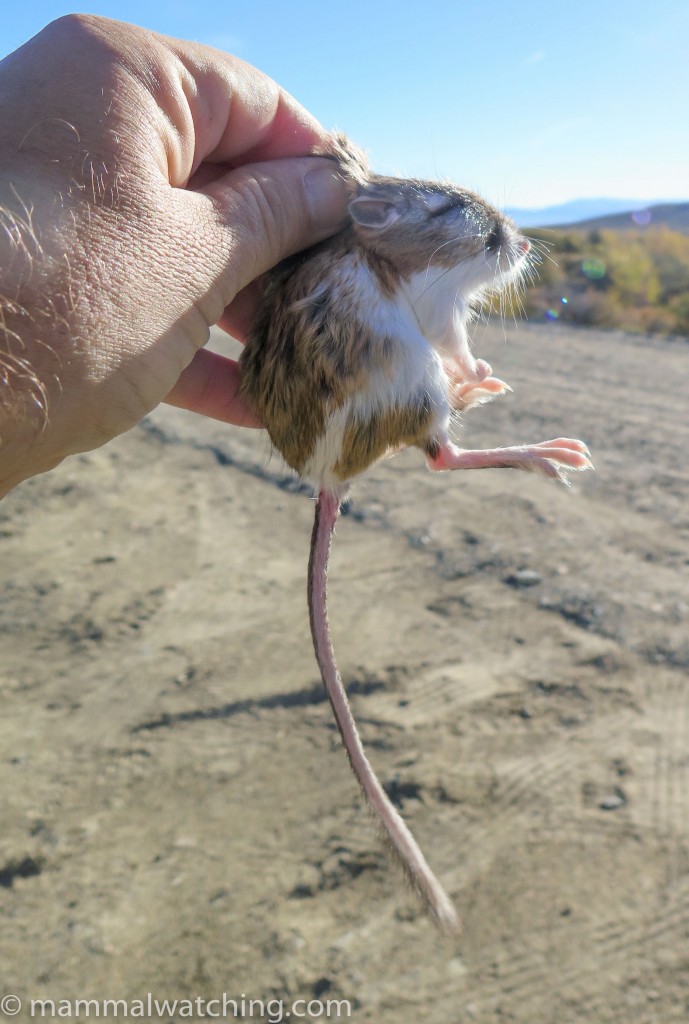
Panamint Kangaroo Rat, Dipodomys panamintinus, Mono Lake
We also caught several Great Basin Pocket Mice, with their distinctive ear lobes, and many Western Deer Mice. There were also Desert and Mountain Cottontails running around.
I returned in September 2017 and caught a couple of Dark Kangaroo Mice and commoner species. I also spent an evening at nearby Owen’s Gorge and saw (and heard) Spotted Bats in flight.
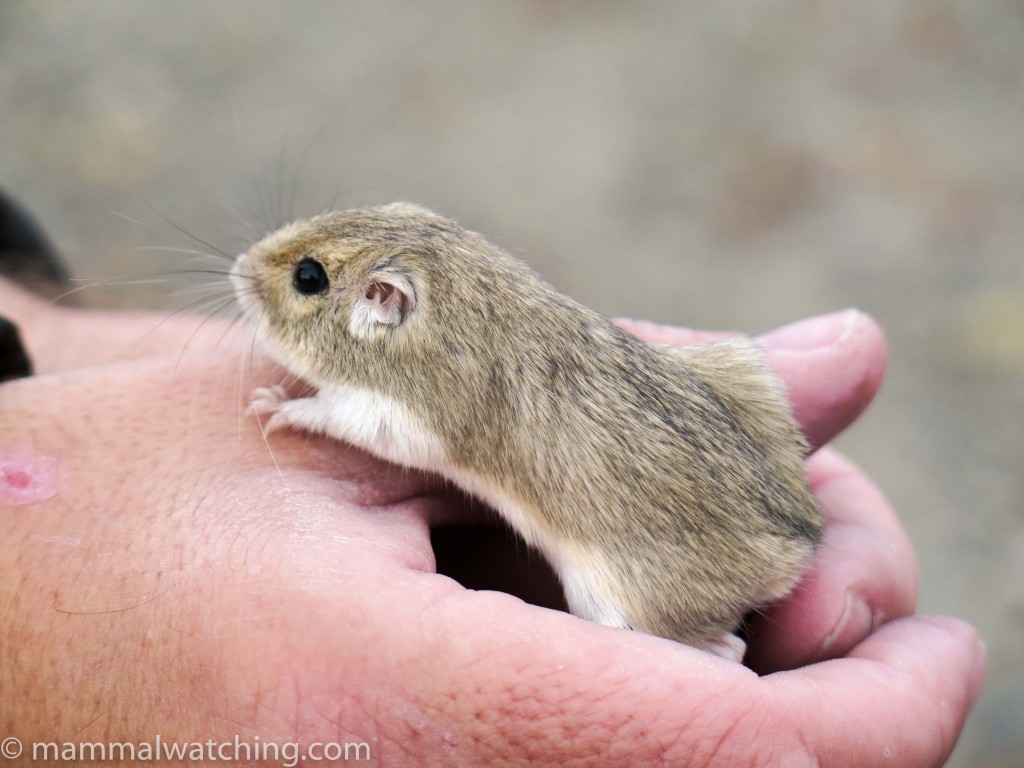
Great Basin Pocket Mouse, Perognathus mollipilosus, Mono Lake
Saddlebag Lake, just up the road towards Yosemite is a beautiful place for a walk. In September 2017 there were Alpine Chipmunks here, as well as Belding’s and Golden-mantled Ground Squirrels.
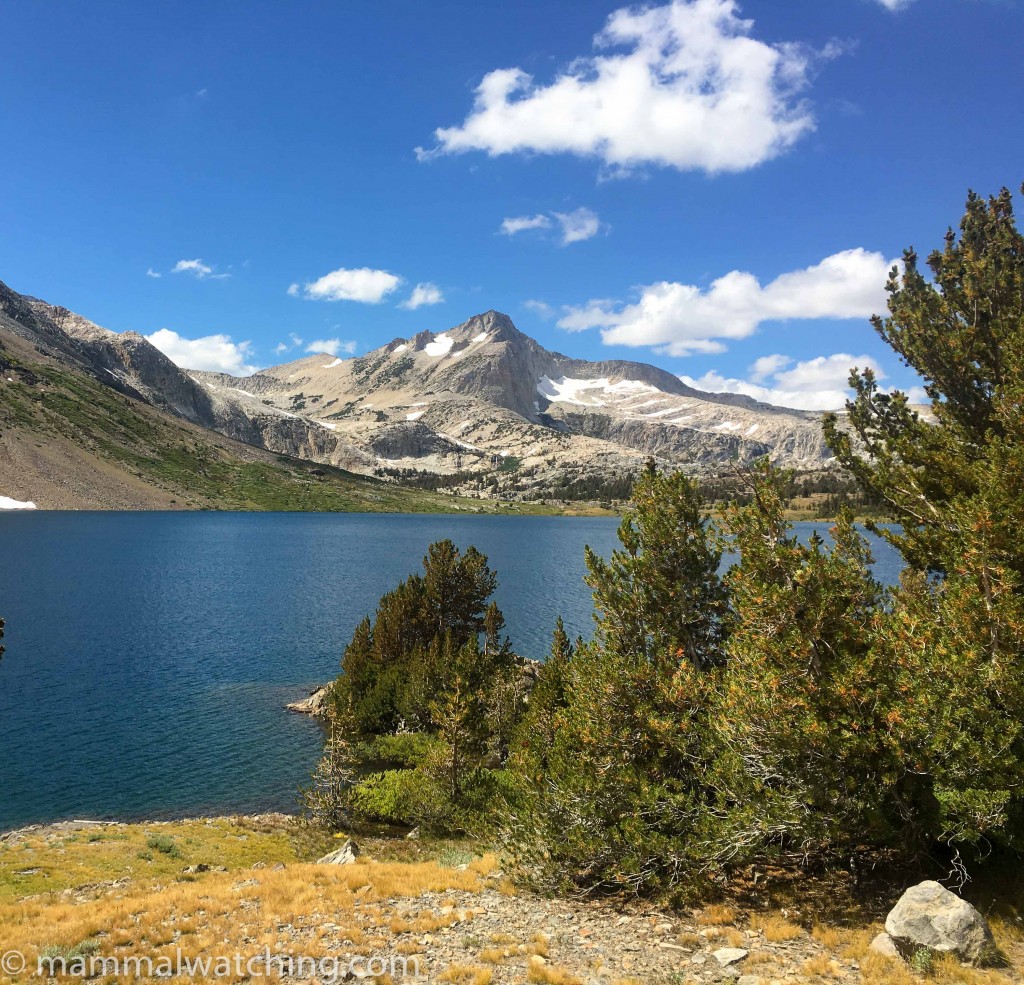
Saddlebag Lake
Yosemite and surrounding areas
Yosemite is a spectacularly beautiful park but gets very busy, especially in summer. I have been several times. In October 1998 I saw Western Gray Squirrels, Alpine Chipmunks, Douglas Squirrels, Gray Foxs and Pallid Bats (roosting in the lodge though I couldn’t find any there in June 2011). I was told Black Bears are common wherever food is.
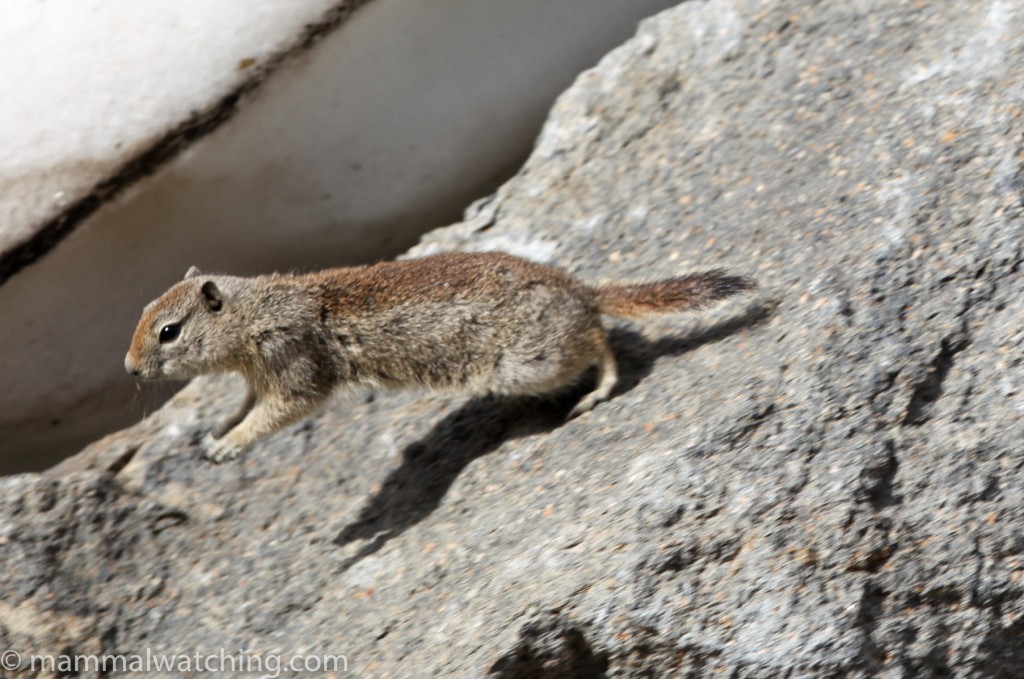
Belding’s Ground Squirrel, Urocitellus beldingi, Mammoth Lakes
In June 2011 I went back and was again amazed by the scenery. I spent a night at Mammoth Lakes, south east of the park, where I hoped to get up to the Devil’s Postpile National Monument to look for Belding’s Ground Squirrels and Lodgepole Chipmunks (which seem to be the only chipmunk there which makes identification easier than usual.
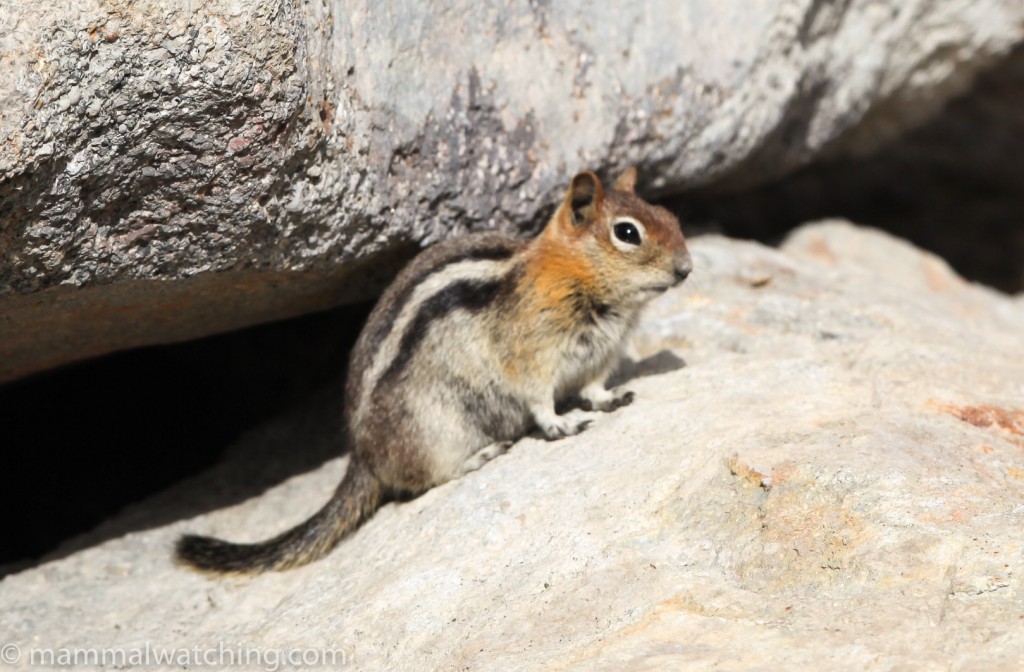
Golden-mantled Ground Squirrel, Callospermophilus lateralis, Mammoth Lakes
The road to the monument was still snowbound but I saw a Belding’s Ground Squirrel and a Golden Mantled Ground Squirrel behind the cafe at the bottom of the ski lift (on the way out of town along 203 towards the national monument). I saw plenty more of both species, plus lots of Lodgepole Chipmunks and a very fat Black Bear on the Mammoth Lakes Scenic Loop (I’m pretty sure that Lodgepole Chipmunks are the only species here too).
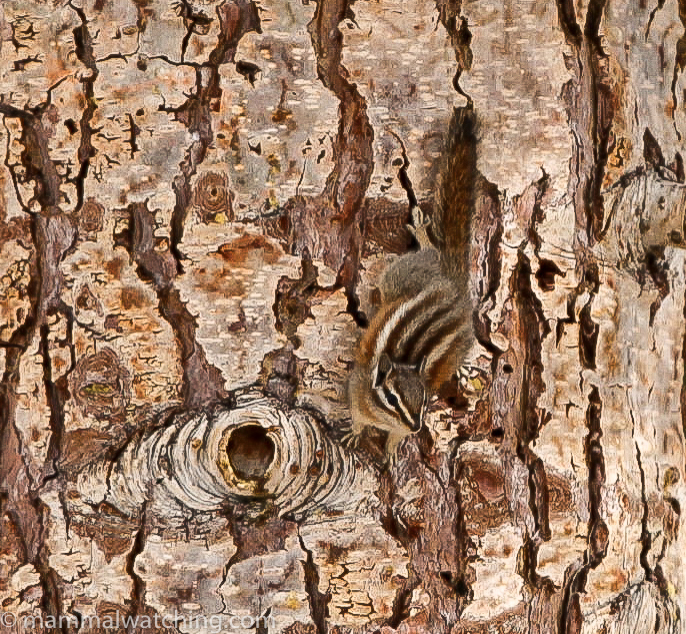
Lodgepole Chipmunk, Tamias speciosus, Mammoth Lakes
On the way from Mammoth Lakes to Yosemite along 108 (highway 120 was still closed to snow) I saw all three species again along with Western Gray Squirrels and Mule Deer.
I spent the next morning looking for Chipmunks and saw plenty of Long-eared Chipmunks and at least one Allen’s (Shadow) Chipmunk at the start of the Merced Grove Trailhead (thank you Morgan Churchill). The Long-eared were common but the Allen’s were hard to find and it seems this species has declined drastically in the past 100 years. It was here I discovered that chipmunks – at least Long-eared – respond very well to squeaking.
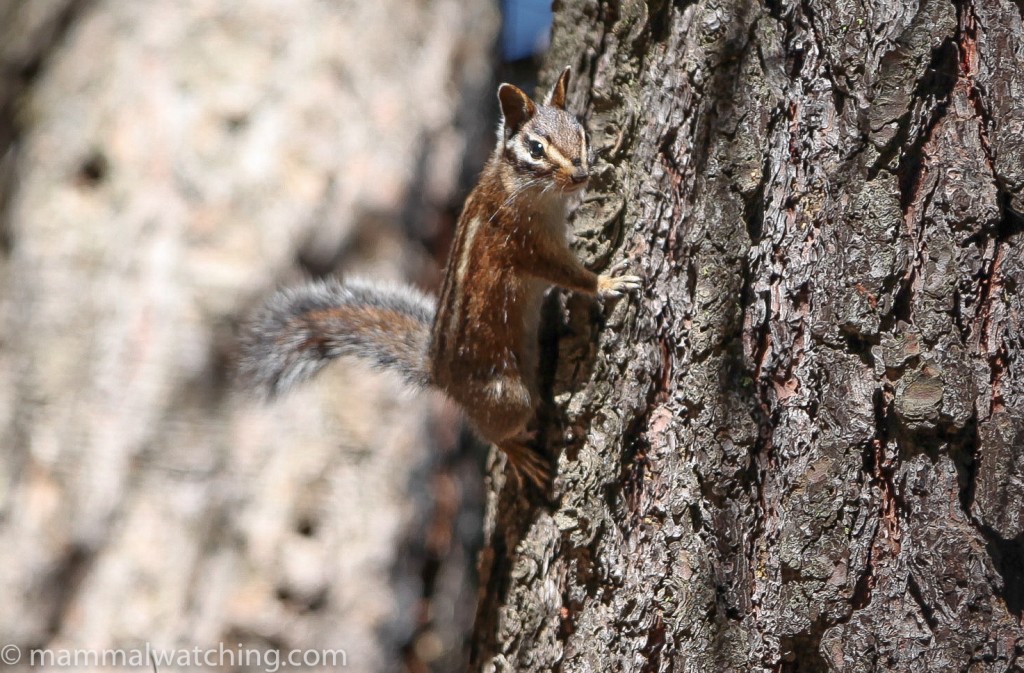
Long-eared Chipmunk, Neotamias quadrimaculatus, Merced Grove
Desert
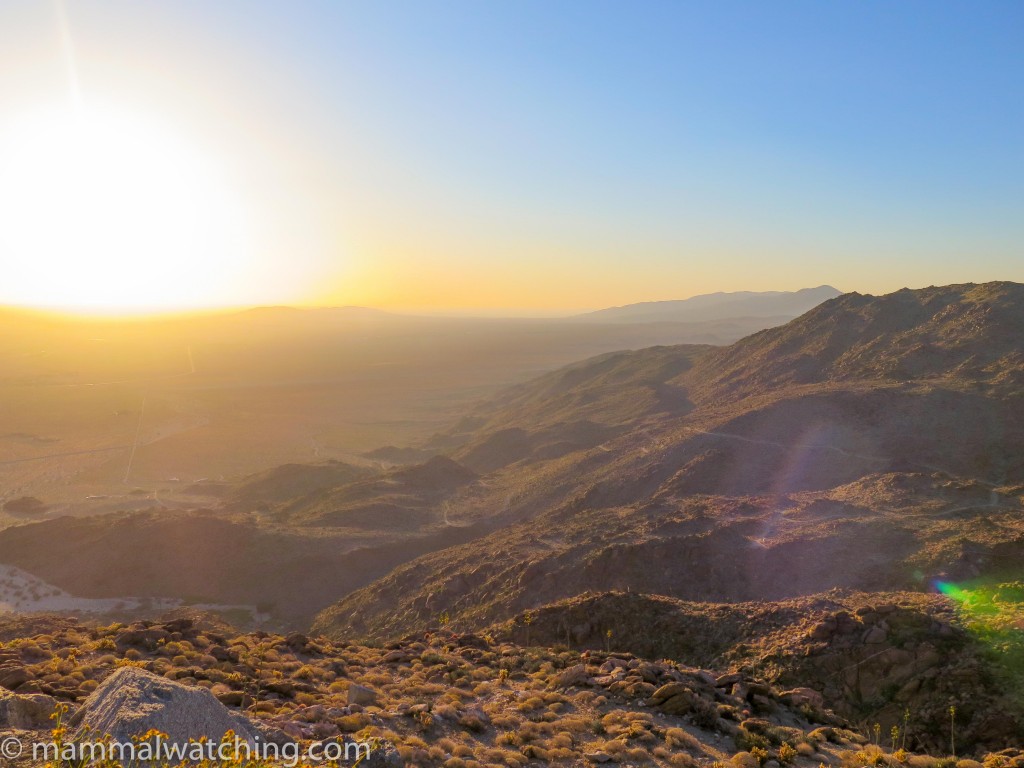
Anzo Borrego State Park
Anzo Borrego State Park
I spent a night here in April 2015 and saw eight kangaroo rats around the Palm Canyon Campsite, at least some of which were most probably Dulzura Kangaroo Rats (though there are also Merriam’s Kangaroo Rats here so you really need a photograph or to catch one to be sure in my opinion). I saw a Kit Fox at sunset on the rocky slopes just south of town, and Black-tailed Jackrabbits and Desert Cottontails were common after dark. See my 2015 trip report.
Colorado River
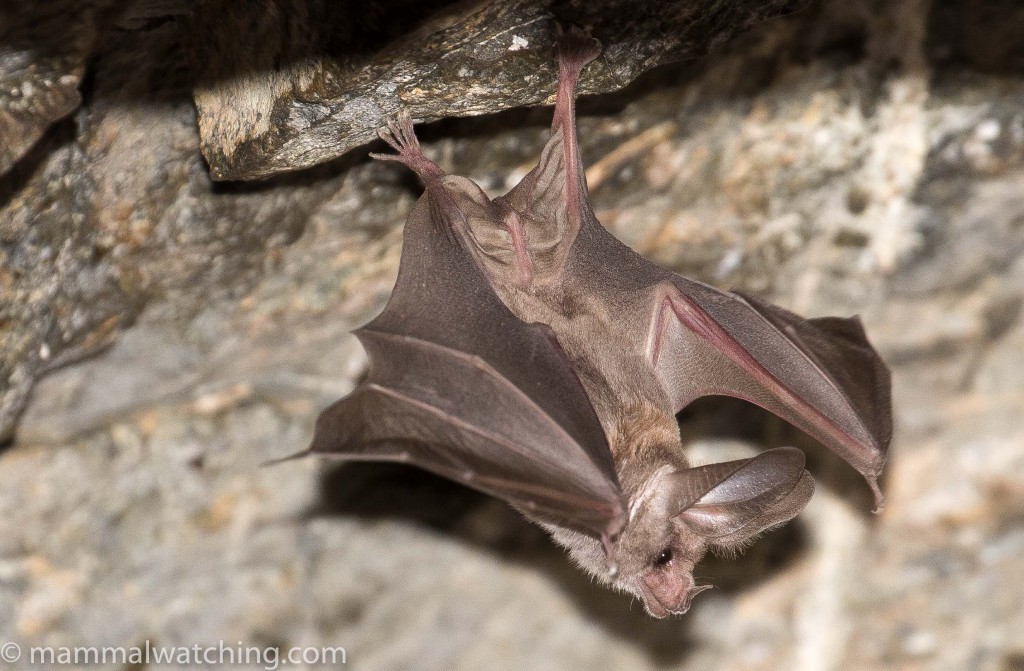
California Leafnosed Bat, Macrotus californicus. Old Stonehouse Mine.
There are some nice bats in bridges across the Colorado River and in May 2017 I saw California Leafnosed Bats at the Old Stonehoue Mine and the Lugo Road Bridge. There were also Yuma Myotis and Mexican Freetails in a nearby bridge, plus a Kit Fox and a Long-tailed Pocket Mouse at the Storehouse Mine.
Hemet
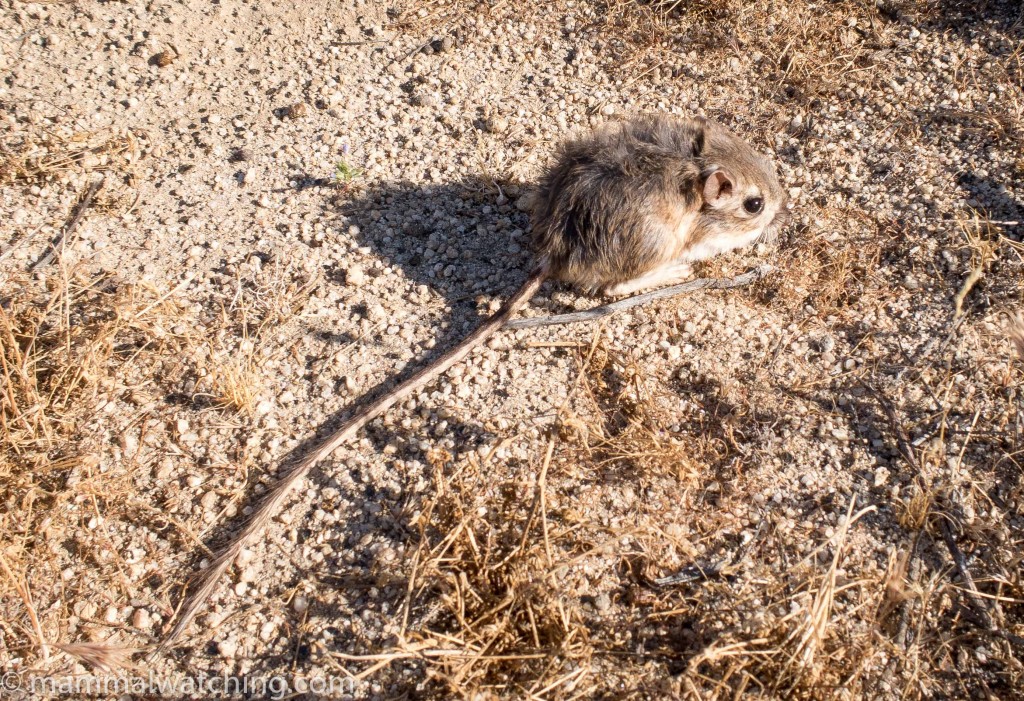
Dulzura Kangaroo Rat, Dipodomys simulans
This seems to be the best area to look for rare Stephen’s Kangaroo Rats. I also found Dulzura Kangaroo Rats, Northern Baja Mice, San Diego Pocket Mice and a Southern Grasshopper Mouse around here. Details in my May 2017 report.
Joshua Tree National Park
I love this park which I first visited in September 1998 and saw Black-tailed Jackrabbits, Desert Cottontails, California Chipmunks, White-tailed Antelope Squirrels, Grey Foxes, a Sonoran Desert Pocket Mouse and a Western Pipistrelle. I went back in December 2014 but saw very little other than a Desert Pocket Mouse just outside the park in the Mecca Hills Wilderness Area. In April 2015 I caught a Desert Kangaroo Rat and Desert Woodrat just outside the park. Spotlighting was poor though I did see Bobcat. See my 2015 trip report.
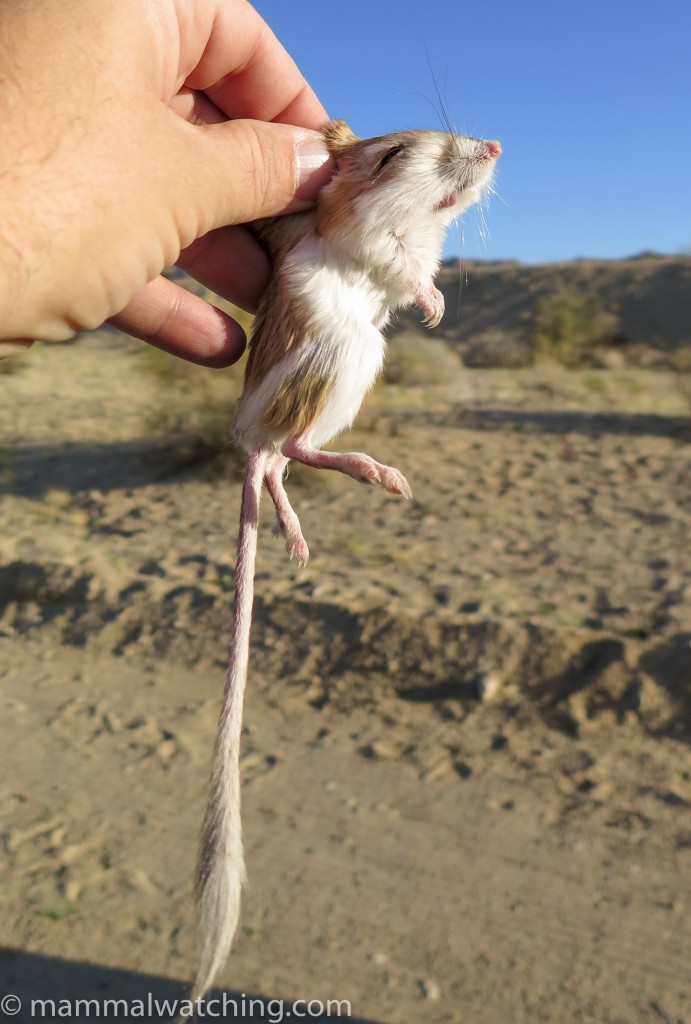
Desert Kangaroo Rat, Dipodomys deserti
In May 2017 rodent numbers were booming in the desert. I saw or caught Cactus and Canyon Mice, Spiny and San Diego Pocket Mice, Desert and White-throated Woodrats and a Merriam’s Kangaroo Rat near Joshua Tree. We also saw a Kit Fox. In June 2020 just south of Joshua Tree there were a similar set of species though the pocket mice were represented by Long-tailed and Baja Pocket Mice.
Lancaster
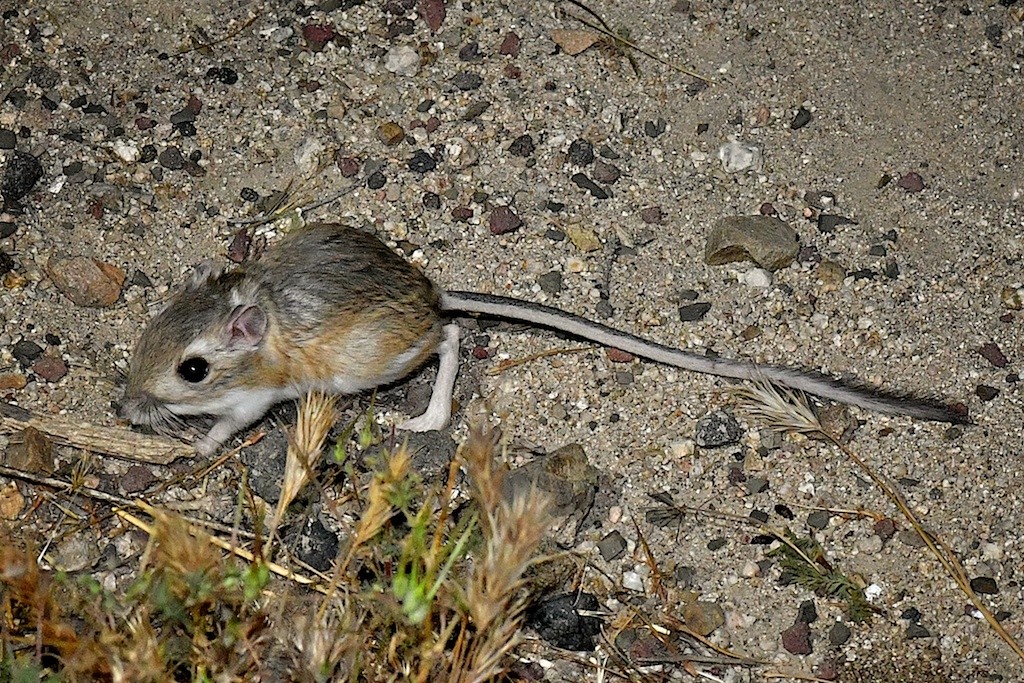
Agile Kangaroo Rat, Dipodomys agilis. Photo by Charles Hood.
Munz Road near Lancaster is a good place to see Agile Kangaroo Rats. Details in my May 2017 report.
Mojave Desert
In June 2011 I spent a day looking for Mohave Ground Squirrels. I couldn’t find any in the area between Red Rock Canyon and Inyokern, though did see plenty of White-tailed Antelope Squirrels and Black-tailed Jack Rabbits.
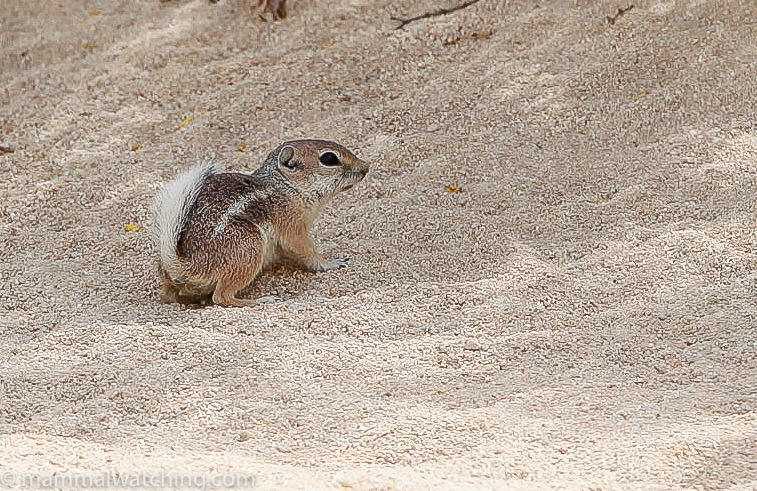
White-tailed Antelope Squirrel, Ammospermophilus leucurus, Mojave Desert
I finally found a Mohave Ground Squirrel in the Desert Tortoise Natural Area just north of California City. It was hard to find the park entrance, but I eventually stumbled on the visitor’s area (just a car park, a trail and a visitor centre inside an RV). By a strange coincidence the ranger had just returned to the US after 12 years in the Luangwa Valley in Zambia and so we had some friends in common. She quickly found me a Mohave Ground Squirrel right behind her RV.
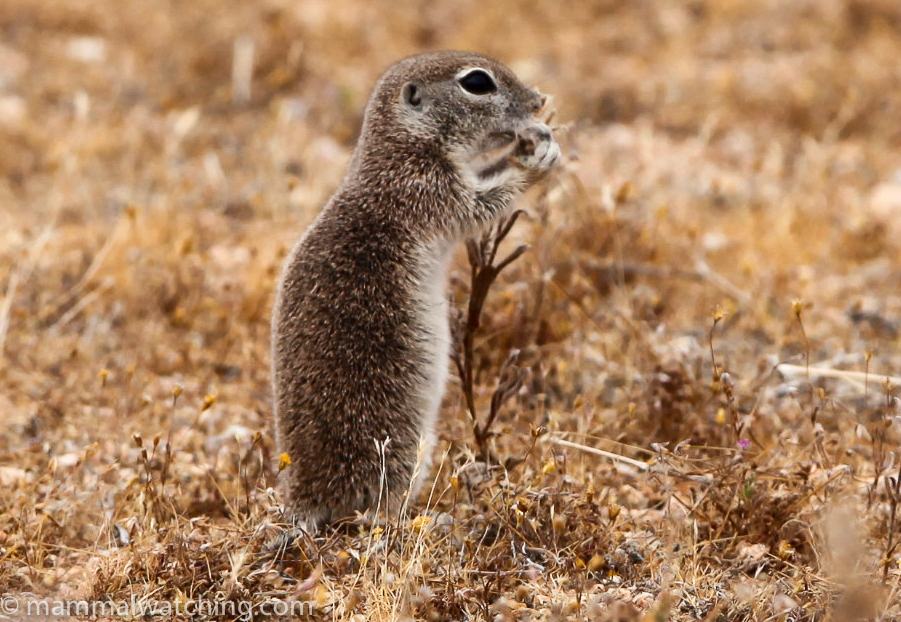
Mohave Ground Squirrel, Spermophilus mohavensi, Desert Tortoise Natural Area
There were more antelope squirrels on the reserve and I saw a California Ground Squirrel when I was leaving California City.
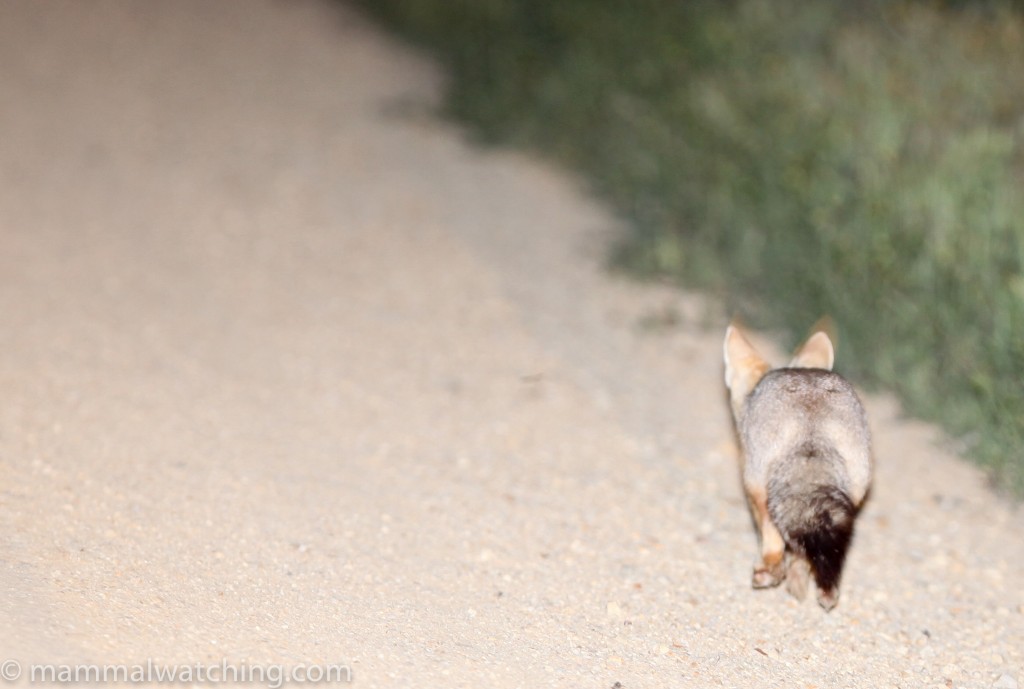
Kit Fox, Vulpes macrotis, Carizo Plain
Community Reports
The World’s Best Mammalwatching
California has a lot of great mammalwatching, but best of all is the California coast. Whale watching doesn’t get any better than in Monterey Bay, where day trips frequently see more than 10 species of sea mammal. This is one of the best places in the world to see Blue Whales, gorgeous Northern Right Whale Dolphins or enormous “mega pods” of dolphins in their thousands. Epic stuff. See my 2015 report for a taste. Nancy Black’s Monterey Bay Whale Watch is the company to sail with. See more of the World’s Best Mammalwatching.
I’ve split the community reports into five broad (and fuzzily defined) regions, as this is such a rich area for reports (and mammals): North Coast (north of San Francisco); Central Coast (from Santa Barbara to San Francisco); South Coast (south of Santa Barbara); the Mountains (including Yosemite); and Desert (including the Mojave and Joshua Tree parks). Reports covering more than one area are listed first under “General”.
General
California Big Mammal Year, 2024: Venkat Sankar and Nicole Haseley’s fantastic report (and associated information) on 150 mammal species including Mountain Lion, Montane Shrew and Mojave Ground Squirrels.
An update on California chipmunk IDs and ranges, 2023: Venkat Sankar’s guide to the best places to see – without an ID doubt – several species of chipmunk including Siskiyou, Allen’s and Yellow-cheeked.
California and Arizona, 2024: Ian Thompson, 2 weeks & 66 species including Trowbridge’s Shrew, Mexican Fox Squirrel, 7 Kangaroo Rat species, Southern Grasshopper Mouse, Collared Peccary and Kit Fox.
California, October 2023: John Wright, 3 weeks & 46 species including Dusky-footed Woodrat, California Vole, Townsend’s Big-eared Bat, Western Bonneted Bat and American Badger.
California and Oregon, June 2020: Jon Hall with mammals including Long-tailed Weasel, Humboldt’s Flying Squirrel, Camas Pocket Gopher and Baja Pocket Mouse.
California, Utah & Arizona, 2019: Jan Ebr, 3 weeks & 31 species including Round-tailed Ground Squirrel, Ringtail & Arizona Grey Squirrel.
Southern California Sites (mainly the LA area), 2018: Gary Skipper’s help guide to reliable sites for several species including Red Fox, Grey Whales and White-tailed Antelope Squirrel.
California, 2017: Sophie and Manuel Baumgartner, 10 days & 24 species including Western Spotted Skunk.
California, Oregon, Idaho, Montana, Wyoming, Utah & Nevada, 2017: Jan Ebr, 4 weeks & 31 species including Grizzly, Wolf and a variety of chipmunks.
California and Arizona, 2017: Dominique Brugiere, 1 month and many species including American Marten, Kit and Island Foxes, Hooded Skunks and Black-footed Ferrets.
Western USA, 2017: Romain Bocquier, 40 days & 84 species including Hooded Skunk, Fisher and Banner-tailed Kangaroo Rat.
Northern California, 2016: Wise Birding, 10 days & 30 species including Northern Fur Seal and Baird’s Beaked Whale.
USA, 2016: Samuel Marlin, several trips & 25 species including Moose and Southern Bog Lemming in New England, and Kit and Island Foxes in California
Chasing Squirrels and Chipmunks in the West, 2016: Andy Murch, 2 weeks. 1 marriage proposal & many rodents including Hopi and Cliff Chipmunks.
Kangaroo Rats & Bats, 2016: Notes from Charles Hood on several species including Desert and Panamint Kangaroo Rats and Spotted Bats.
California, 2016: Matt and Maureen Hart, 2 weeks & 40 species including Northern Right Whale Dolphins, Northern Fur Seal, Long-tailed Weasel and San Joaquin Pocket Mouse.
California Weekend, 2016: Vladimir Dinets, 1 week & some nice species including Mojave Ground Squirrel, Dark Kangaroo Mouse, Agile Kangaroo Rat, Pygmy Rabbit and White-eared Pocket Mouse.
Central California, 2015: Mike Richardson, 10 days & 43 species including Kit Fox, Panamint, San Joaquin, Heerman’s and Giant Kangaroo Rats, Bobcat, River Otter and Snowshoe Hare.
California & Arizona, 2015: Simon Feys, 3.5 weeks & an impressive 74 species, including Western Yellow Bat, Long-tailed Weasel, Black-footed Ferret, and some nice rodents.
Western USA, 2015: Michael Kessler, 6 weeks & 88 species(!) including Spotted Bat, Northern Right Whale Dolphins, Long-tailed and Water Voles, Wolf and Long-tailed Weasel.
Southern California Heteromyid Grandslam, 2014: Fiona Reid & Vladimir Dinets, 9 days & an impressive 75 species including a lot of Pocket Mice, some nice Kangaroo Rats, Pygmy Rabbit, Western Yellow Bats and Orca.
Western USA, 2014: Janco van Gelderen, 3 weeks & 41 species/ssp including Bobcat, Grizzly and Long-tailed Weasel (15mb download).
California, 2013: Mark Hows, 2 weeks & 46 species including Northern Flying Squirrel, American Badger and Shrew Mole.
Yosemite and Point Reyes, 2012: Tomer Ben-Yehuda, days & 16 species including Marten, Bobcat and a Northern Flying Squirrel.
Florida & California, 2013: Romain Bocquier, 10 days & 20 species including River Otter, Long-tailed Weasel and Bobcats.
California and Arizona, 2010: Richard Webb, 9 days & 15 or so mammals including Bobcat and Kit Fox.
California, 2010: Coke Smith, 2 weeks & 30 species including Botta’s Pocket Gopher, Kit Fox and American Badger.
South-western USA, 2004: Steve-Anyon Smith, one month in Arizona, California and Texas & 46 mammals including an Armadillo.
North Coast (north of San Francisco)
An update on California chipmunk IDs and ranges, 2023: Venkat Sankar’s guide to the best places to see – without an ID doubt – several species of chipmunk including Siskiyou, Allen’s and Yellow-cheeked.
Bobcats, 2024: Cat Expeditions, 5 days & 6 species including Badger Long-tailed Weasel and 20! Bobcats.
The Farallon Islands & Point Reyes, 2024: Ellen Linton, 3 days & 24 species including Northern Right Whale Dolphins, North American River Otter, and a surprise Cougar!
Bobcats, 2023: Cat Expeditions, 3 x 3 night trips with great Bobcat and Badger photos.
Point Reyes (California) & Gunflint Trail (Minnesota), February 2023: Samuel Marlin, 2 weeks & 24 species including Lynx, Bobcat, Badger and Northern Bog Lemming.
Point Reyes & Monterey, March 2023: Greg Easton, 3 days & 16 species including Badger, Bobcat and Steller’s Sealion.
Bobcats in Marin Country, California, 2022: great pictures from a 4 day Cat Expedition trip with other species including Coyote and Tule Elk.
Northern California, February 2022: Wise Birding Holidays, 10 days & 21 species including Bobcats, River Otters and Grey Whales.
Humboldt County, 2021: Venkat Sankar’s notes on various species including Sonoma Tree Vole nests, Dusky-footed Woodrat and Yellow-cheeked Chipmunk. (See a 2023 update on Chipmunks ID’s here).
Bobcat Quest (Point Reyes), 2020: Stuart Chapman, 4 days and 19 species including Badger, Bobcat and River Otter.
Pacific Northwest, 2019: Daan Drukker, 3.5 weeks & 40 species including Long-tailed Weasel, Northern Rightwhale Dolphin, and Allen’s Chipmunk. Great report.
Muir Woods, 2018: Vladimr Dinets, 2 hours & 5 species including Fog Shrew and Dusky-footed Woodrats.
Sacramento Valley, 2016: Venkat Sankar’s account of a night’s spotlighting including California Kangaroo Rat, Ringtails and an Ornate Shrew.
Point Heyes & Martinez, 2015: Charles Hood, a very brief report of a couple of nights including a Beaver and a Gray Fox.
Colorado & a little bit of California, 2014: Michel Watelet, 2 weeks & 34 species including Bobcat, Abert’s Squirrel and Bighorn Sheep.
Point Reyes, 2014: Alan Dahl, 3 days & 11 species including 6 separate Bobcats.
Point Reyes, 2013: Alan Dahl, 3 days & 11 species including Bobcats, Badger and Mexican Free-tailed Bats.
Point Reyes, 2011: Alan Dahl, 5 days & 13 species including 4 Bobcats, a Long-tailed Weasel and a Botta’s Pocket Gopher.
Central Coast (from Santa Barbara to San Francisco)
Monterey Bay Photo Tour, 2024: Whale Expeditions, 6 days & 7 species including Humpbacks, Sea Otters and Orcas.
Carizo Plain overnight, 2025: Eddie Pollau, 1 night & 4 species including Giant Kangaroo Rat and San Joaquin Antelope Squirrel.
LA to San Francisco, 2025: Tom Terleph, 5 days with species including Badger, Kit Fox and Bobcat.
California & Death Valley, 2023: John Wright, 1 week & 27 species including Giant and Panamint Kangaroo Rats, Island Fox and Northern Right Whale Dolphins.
Bay Area, 2023: Jon Halll’s report of a long weekend featuring 13 species including Guadalupe Fur Seals and San Joaquin Pocket Mice.
Monterey Bay, 2023: Bud Lensing, 2 days & several species including Northern and Guadalupe Fur Seals and Blue Whale.
Point Reyes & Monterey, March 2023: Greg Easton, 3 days & 16 species including Badger, Bobcat and Steller’s Sealion.
Pinnacles NP, 2021: Venkat Sankar’s report of 3 hours and several species including Dusky-footed and Bryant’s Woodrats and Pinyon Mouse and Western Mastiff Bats.
A good year for Guadalupe Fur Seals?, 2020: Charles Hood’s report of a Guadalupe Fur Seal out of Half Moon Bay.
California, 2020: Wise Birding, 11 days & 25 species including American Badger and Northern Right Whale Dolphin.
Bay Area, 2019: Jon Hall. A short trip with species including Northern Fur Seals, Western Spotted Skunks and Botta’s Pocket Gophers.
Monterey Bay, 2019: Michael Johnson’s notes of an easy mammal trip.
Carizo Plain from Dusk til Dawn, 2019: Gary Skipper, 1 night & about 10 species including Kit Foxes and a likely San Joaquin Pocket Mouse.
Update to Monterey & Point Reyes, 2018: Charles Hood’s notes on the presence (and absence) of various species including Western Spotted Skunks, Bobcats and Long-tailed Weasels.
Monterey Weekend, 2017: Jon Hall, 3 days & 17 species including Northern Right Whale Dolphins and Kit Foxes.
Carizo Plains, 2017: Charles Hood’s brief update on kangaroo rats on the plains.
Panoche Valley Spotlighting (May 2017): Venkat Senkar, one night and rodent’s galore including Southern Grasshopper Mouse and Narrow-faced Kangaroo Rats plus Badgers and more.
Bay Area Weekend, May 2016: Jon Hall including Northern Right Whale Dolphins and California Pocket Mice.
Update on Panoche Valley, Central California (Jan 2016): Venkat Sankar’s notes on rodents, Kit Foxes and Bobcats after January rain.
California Update, 2016: Venkat Sankar’s account of a productive night in July in the Panoche Valley, featuring 4 species of Kangaroo Rat (including Narrow-faced Kangaroo Rat), Southern Grasshopper Mouse and a Western Mastiff Bat.
Bobcat Safari, 2015: Venkat Sankar, 2 day Bobcat Safari in Central California with 9 species with 7 Bobcat sightings!
Big Mammal Day, 2015: Brian and Eileen Keelan join forces with Peter Pyle and Floyd Hayes to smash the US record with 42 species between them including Shrew-Mole, Mountain Beaver, Badger, Western Harvest Mouse and Bonneted Bat.
Big Mammal Day, 2014: Brian & Eileen Keelan, and an impressive 27 species in 24 hours centred on the Santa Cruz mountains. Some nice bats including Red and Western Mastiff, but no Raccoons!
Panoche Valley, 2014: Vladimir Dinets. Giant and Heerman’s Kangaroo Rats and a Kit Fox in a night’s spotlighting.
Big Mammal Day, 2013: Floyd Hayes, a record breaking 24 hours & 33 species including Bobcat, Pacific Jumping Mouse and Northern Fur Seal.
The Pinnacles and Carizo Plain, 2013: Alan Dahl, 2 days & 8 species including Giant Kangaroo Rat.
California, 2012: Michal Polanski, 4 days & 8 species including Dusky-footed Woodrats.
Santa Cruz Island & the Carizo Plains, 2012: Charles Hood and some notes on the Island Foxes and other widlife.
South-western USA, 2009: Mike Richardson, 3 weeks in Arizona, California and Texas & 22 species including a Bobcat.
South Coast (south of Santa Barbara)
Western Spotted Skunks in the Channel Islands, 2022: Charles Hood notes that the species is apparently becoming easier to see there.
San Diego 7 day pelagic, 2022: Charles Hood’s report of marine mammals during a week long pelagic birding trip, with the highlights Baird’s Beaked Whales and Guadalupe Fur Seals.
Humboldt’s Flying Squirrel, Big Bear Lake, San Bernadino Mountains, 2020: Paul Carter, 3 nights & 15 species including Large-eared Woodrat, Western Red Bat and Humboldt’s Flying Squirrel.
Southern California Bobcat Site, 2018: Charles Hood’s report on Wind Wolves Preserve and its Bobcats.
Baird’s Beaked Whales and Guadalupe Fur Seals,2018 from San Diego pelagic trips
Botta’s Pocket Gophers, 2018: Charles Hood’s notes on two reliable sites for Botta’s Pocket Gophers near L.A.
Southern California Sites (mainly the LA area), 2018: Gary Skipper’s help guide to reliable sites for several species including Red Fox, Grey Whales and White-tailed Antelope Squirrel.
Southern California Weekend, 2017: Jon Hall, 3 days & 23 species including Stephens’, Agile & Dulzura Kangaroo Rats. Long-tailed and Spiny Pocket Mice, Catcus and Canyon Deer Mice and California Leaf-nosed Bats.
Southern California Weekend, 2017: Venkat Sankar, 4 days & 26 species including Stephens’ & Dulzura Kangaroo Rats, six species of Pocket Mice, Arizona Myotis, Western Yellow Bat, California Leaf-nosed Bat and Spotted Bat! See here for a 2023 update from Venkat on California Chipmunks.
Southern California, 2014: Curtis Hart, 1 week & 10 species including a Desert Pocket Mouse and Canyon Bat.
The Channel Islands, 2013: Cheryl Antonucci, 4 days & 8 or 9 species including Island Foxes, Santa Cruz Deer Mouse and Risso’s Dolphins.
The Pinnacles and Carizo Plain, 2013: Alan Dahl, 2 days & 8 species including Giant Kangaroo Rat.
Mountains (including Yosemite)
Sequoia & Kings Canyons NPs, 2024: Alex Sowers, 2 days & 14 species including Western Mastiff Bat, Humboldt’s Flying Squirrel and a Big-eared Woodrat.
Western USA, 2019: Ralf Bürgin, 10 days & 31 species including Panamint Kangaroo Rat and Water Vole and plenty three subspecies of Bighorn Sheep.
Eastern Sierras, 2017: Jon Hall, 2 days & mammals including Alpine Chipmunk, Dark Kangaroo Mouse, Little Pocket Mouse and Spotted Bat.
Ringtail, 2017: Charles Hood’s short report of various locations including a site for Ringtail near Yosemite.
Eastern Sierras, 2017: Venkat Sankar, 3 days & 29 species including Spotted Bat, Pale and Dark Kangaroo Miceand Merriam’s Shrew.
Lava Beds National Monument, 2017: Charles Hood, 2 days and 16 species including Trowbridge’s Shrew, California Kangaroo Rat and Silver-haired Bat.
Sierra Nevadas, 2016: Vladimir Dinets, brief notes on 3 days around South Lake Tahoe. Species included Vagrant Shrew, Long-tailed Vole and a Water Shrew. and some info here on Sacramento Foxes near Colusa.
South West Great Basin, May 2015: Vladimir Dinets account of a few days around Mono Lake looking for rodents. Species include Dark Kangaroo Mouse, Panamint and Chisel-toothed Kangaroo Rat and Long-tailed Pocket Mouse.
Desert
Southern Cali, 2021: Venkat Sankar, 3 days with species including Giant, Heerman’s and Fresno Kangaroo Rats, Long-tailed Weasel and California Leaf-nosed Bats.
Southern California, 2020: Venkat Sankar, 5 nights and 40 species including Western Mastiff and Pocket Free-tailed Bats, Round-tailed Ground Squirrel and a plethora of rats and mice.
Bobcats Ringtails and Bats: Charles Hood’s notes of a few sites within a few hours of San Diego for species including Bobcat, Ringtail, Western Mastiff Bat and lots of rodents.
Anza Borrego overnight, 2019: Gary Skipper’s account of 14 hours in Anza Borrego with 13 species including Botta’s Pocket Gopher and Desert Kangaroo Rat and Desert Woodrat.
Hemet, early Winter 2017: Mac Hunter’s micro report on an absence of kangaroo rats.
Southern California Weekend, 2017: Jon Hall, 3 days & 23 species including Stephens’, Agile & Dulzura Kangaroo Rats. Long-tailed and Spiny Pocket Mice, Catcus and Canyon Deer Mice and California Leaf-nosed Bats.
Southern California Weekend, 2017: Venkat Sankar, 4 days & 26 species including Stephens’ & Dulzura Kangaroo Rats, six species of Pocket Mice, Arizona Myotis, Western Yellow Bat, California Leaf-nosed Bat and Spotted Bat!
Joshua Tree, 2016: some notes from Matt Miller with species including Bighorn Sheep, Round-tailed Ground Squirrels and Desert Kangaroo Rats.
Joshua Tree Weekend, April 2015: Jon Hall, including Desert and Dulzura Kangaroo Rats and a Desert Woodrat.
South East California to West Texas, 2015: Brian Keelan, 24 days & 43 mammals, 24 of which were bats (the main focus of the trip) including Ghost-faced, Lesser Long-nosed, Allen’s Big-eared (Lappet-browed) and Underwood’s Mastiff Bats, Davis Mountain Cottontail and Mexican Fox Squirrel. Great stuff!
Southern California, 2014: Curtis Hart, 1 week & 10 species including a Desert Pocket Mouse and Canyon Bat.
Also See
Listen to Venkat Sankar & Nicole Haseley talk about their Big California Year on the mammalwatching podcast, April 2025
An update on California chipmunk IDs and ranges, 2023: Venkat Sankar’s guide to the best places to see – without an ID doubt – several species of chipmunk including Siskiyou, Allen’s and Yellow-cheeked.
Is this a California or Steller’s Sealion at Monterey?, March 2025
RFI: Early February in Las Vegas (inc Arizona and California), December 2024
Mojave Ground Squirrel RFI, January 2024
Many Guadalupe Fur Seals in Monterey Bay, August 2023
Island Fox in a day trip? to Santa Cruz Island? April 2023
Ideas for a few days out of LA in August? February 2022
Rodent records from Deep Canyon (near Palm Springs) January 2020
Mojave River Beavers June 2019
Baird’s Beaked Whales off of California May 2019
Muskrat Site in Southern California (Oxnard) August 2018
California RFI with some useful information on northern Chipmunk species especially, March 2017
Harbour Porpoise from land (and bridge) in San Francisco December 2016
Update on Bobcat Site, near Pinnacles National Park December 2016
Botta’s Pocket Gopher – a reliable site 90 mins north of LA on I5 August 2016
Spotted Skunks and more: a few notes from Vladimir Dinets on a rumoured Spotted Skunk site near Monterey. June 2016
Botta’s and Mountain Pocket Gophers near Chico, Ca. (Feb, 2016) and Broad-footed Moles too. May 2016
Arizona and California Mammal Sites (Feb, 2016): some notes from Joshua Smith on where to see a range of species (mainly rodents) including Round-tailed Ground Squirrels and Grey-collared Chipmunks. Some larger mammals are here.
Shrews and Shrew-Moles. July 2015
Devil’s Punchbowl (Gray Fox Site) in Southern California. May 2015
The San Francisco Bay Wildlife Info site with “checklists, identification resources and guides to viewing locations”.
Aplodontia rufa nigra: advice on seeing the Point Arena Mountain Beaver, a black and white subspecies, 150 miles north of San Francisco. March 2015
‘Golden’ Beavers in Martinez, Ca. October 2014
Finding Mammals in North America RFI . Some interesting discussion in the comments on sites for Northern Flying Squirrel, Aplodontia and Western Spotted Skunk in Humboldt County. September 2014
RFI – Pinnacles NP and Carrizo Plain. March 2013
Sequoia/King’s Canyon National Park and Point Reyes. December 2012
RFI – California Bats/Small Mammals. September 2012
RFI Squirrels of California with information on Belding’s Ground Squirrel and some of Yosemite’s Chipmunks. June 2011
ID confirmation of a couple Carrizo Plains Rodents. October 2010
Redwoods National Park, CA – RFI. February 2010
Resources
A guide to the kangaroo rats and mice of California, October 2023


Leave a Reply
You must be logged in to post a comment.